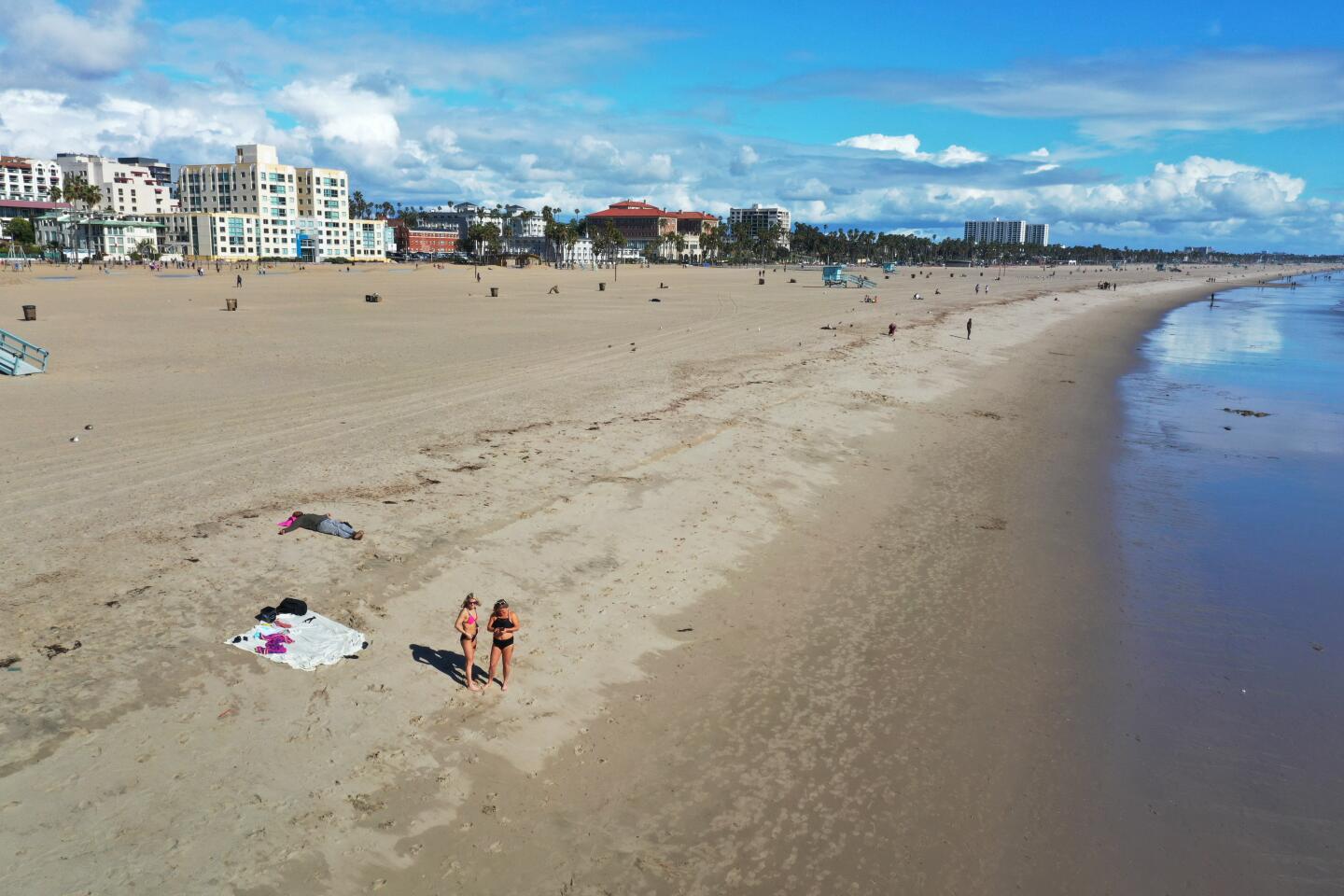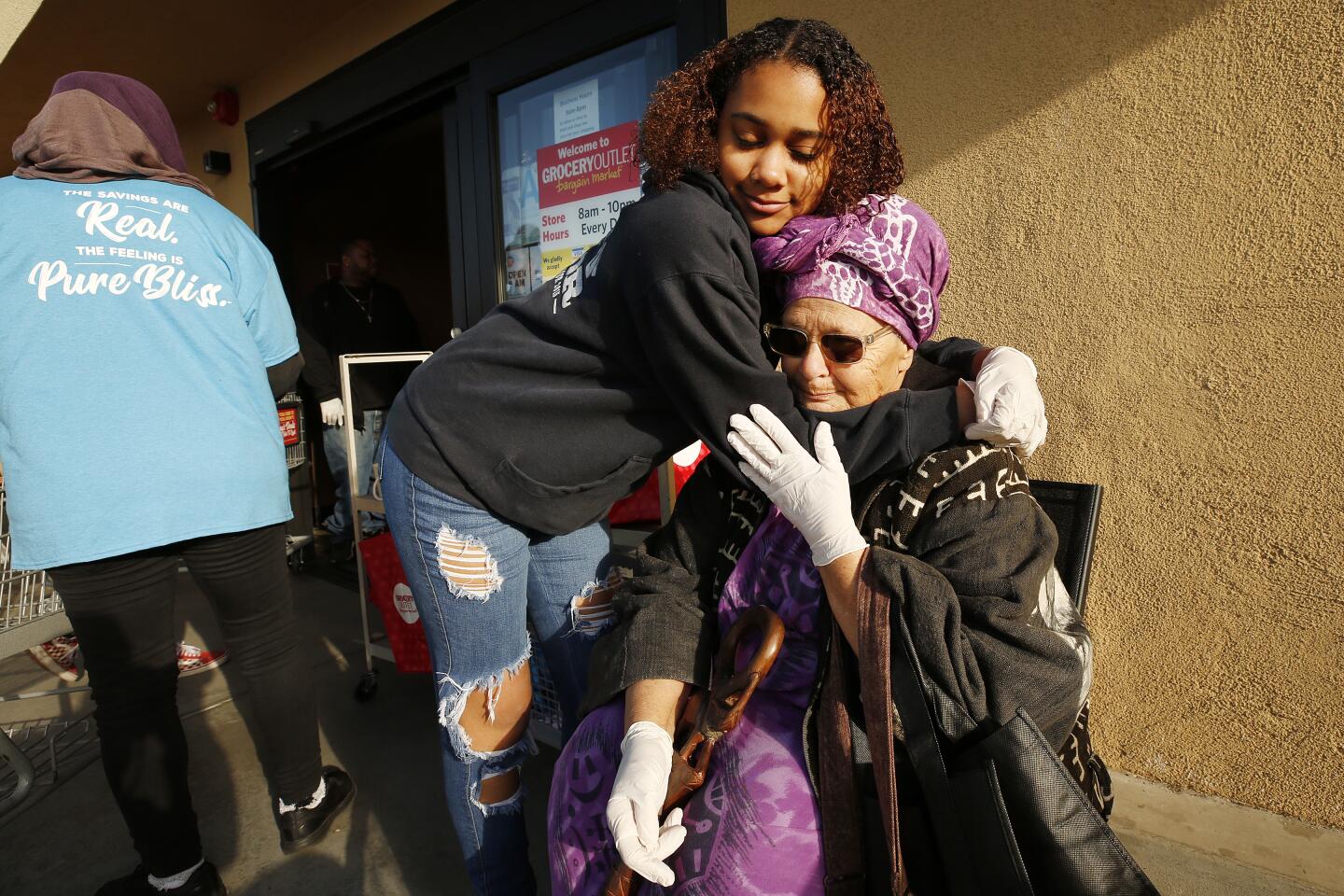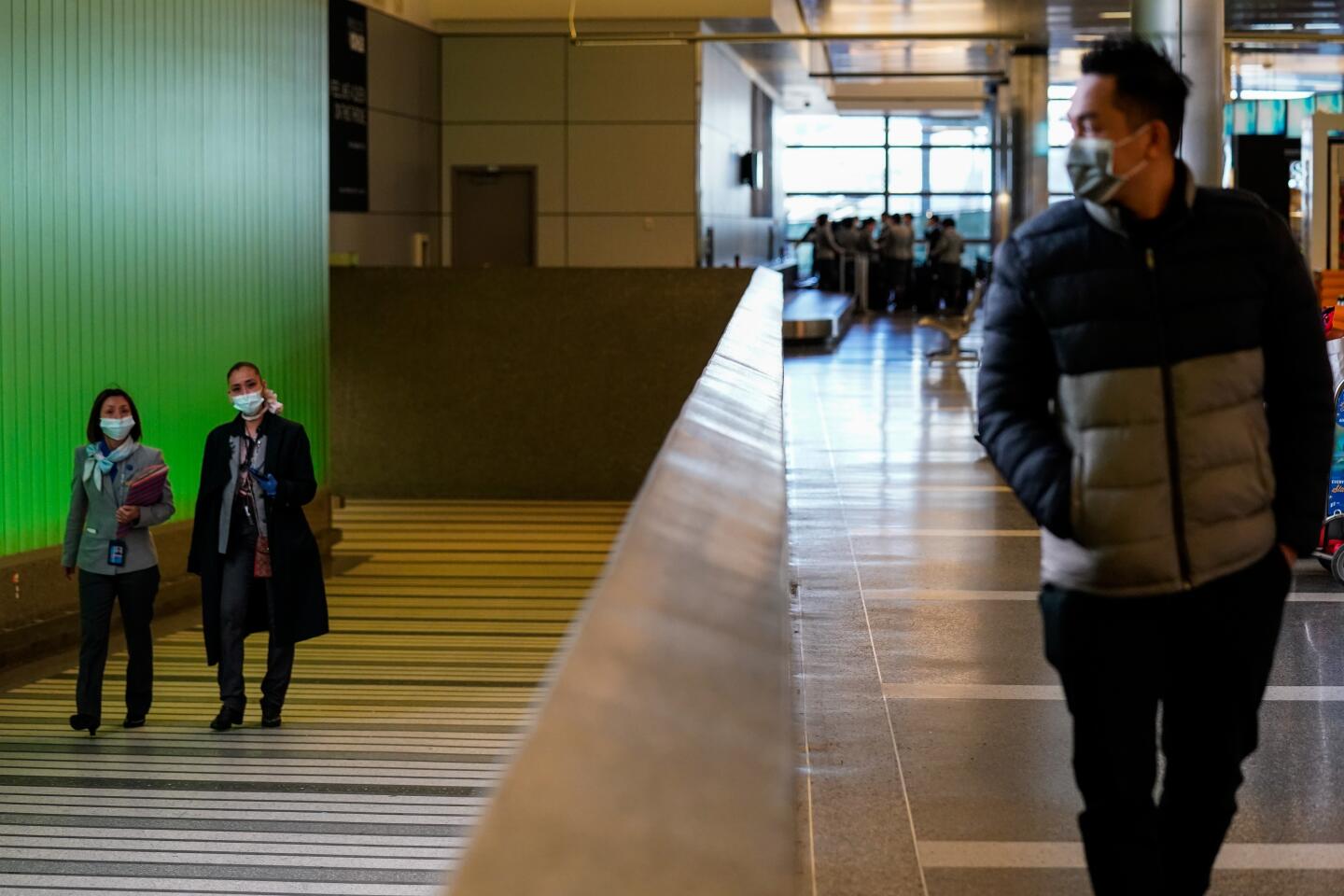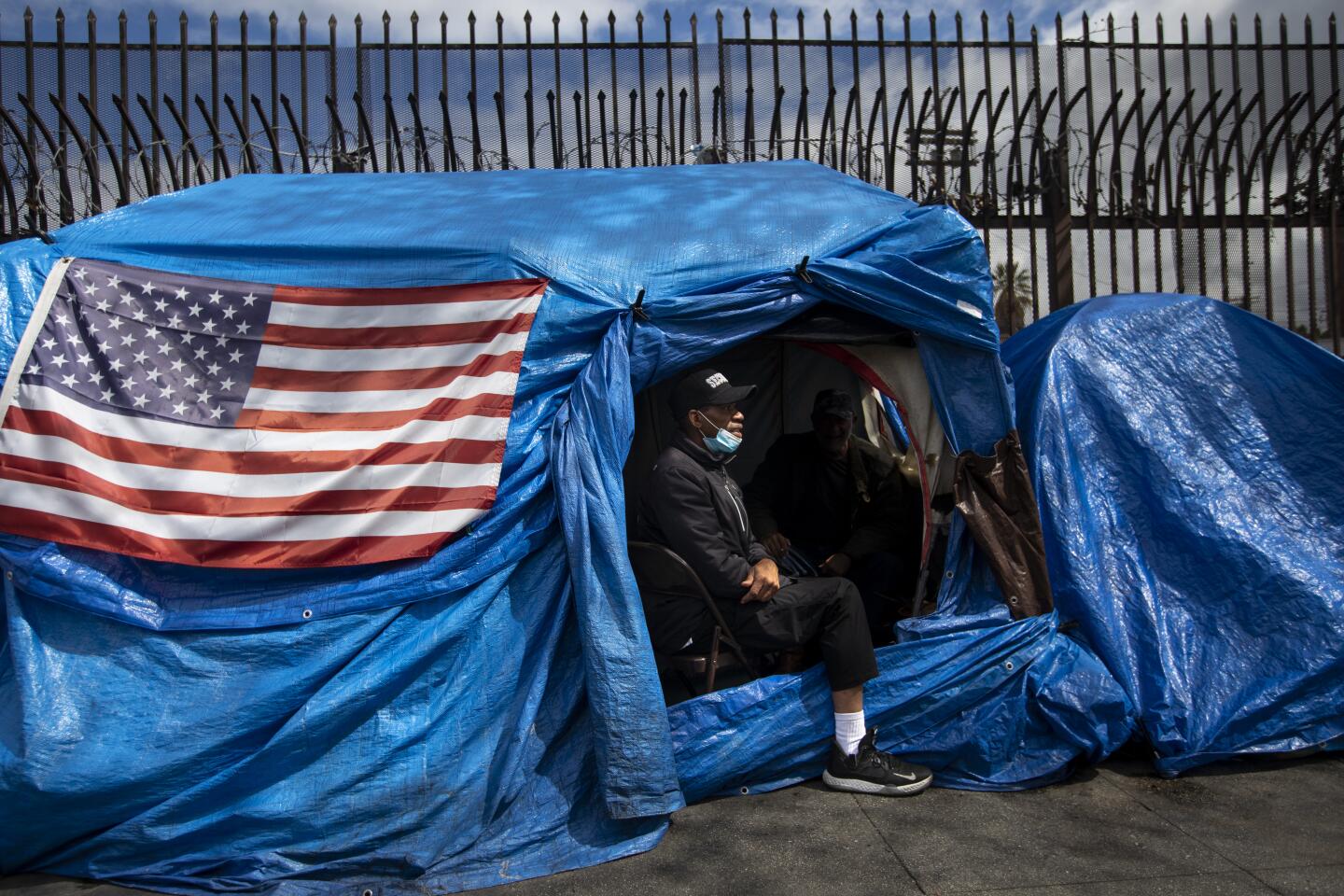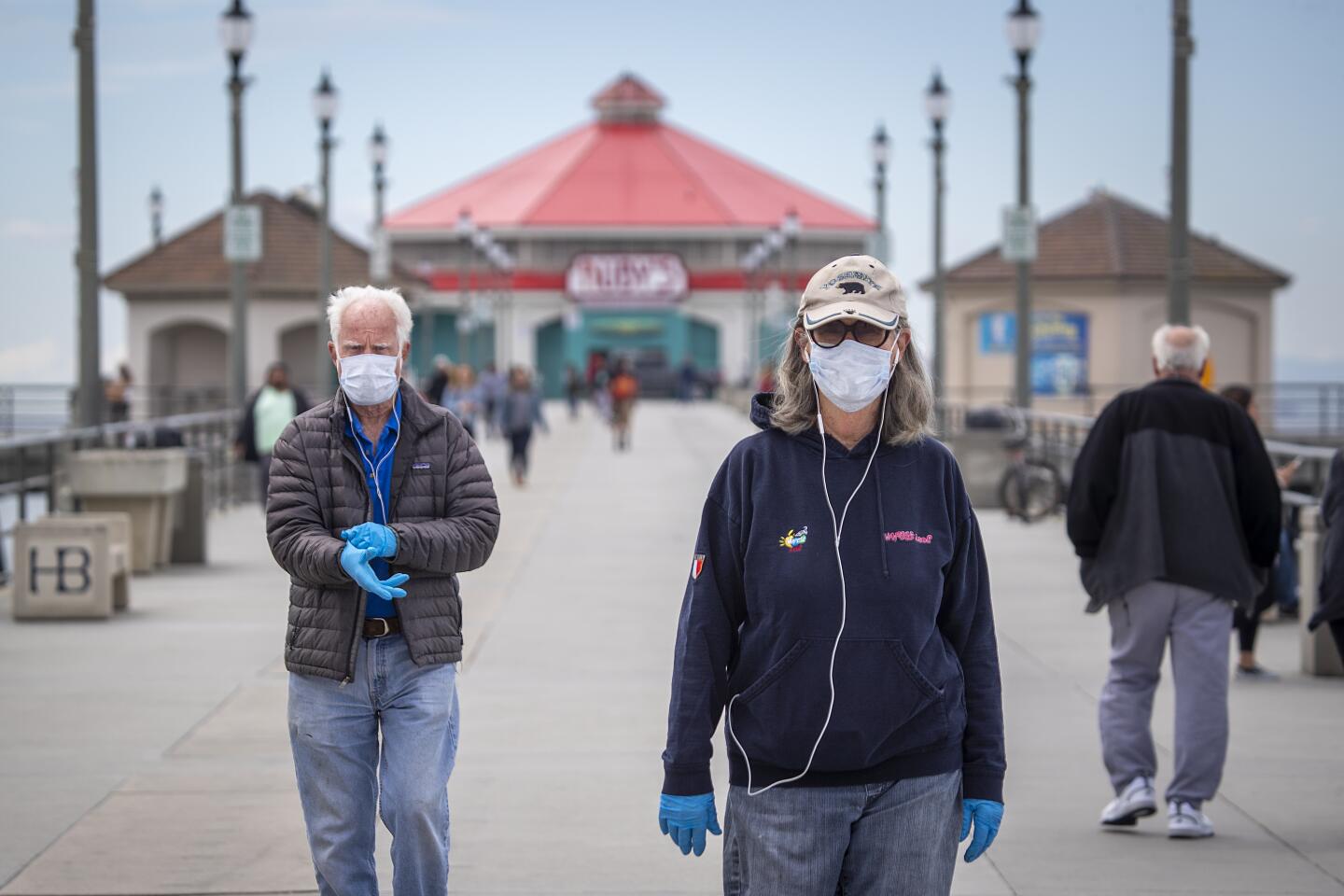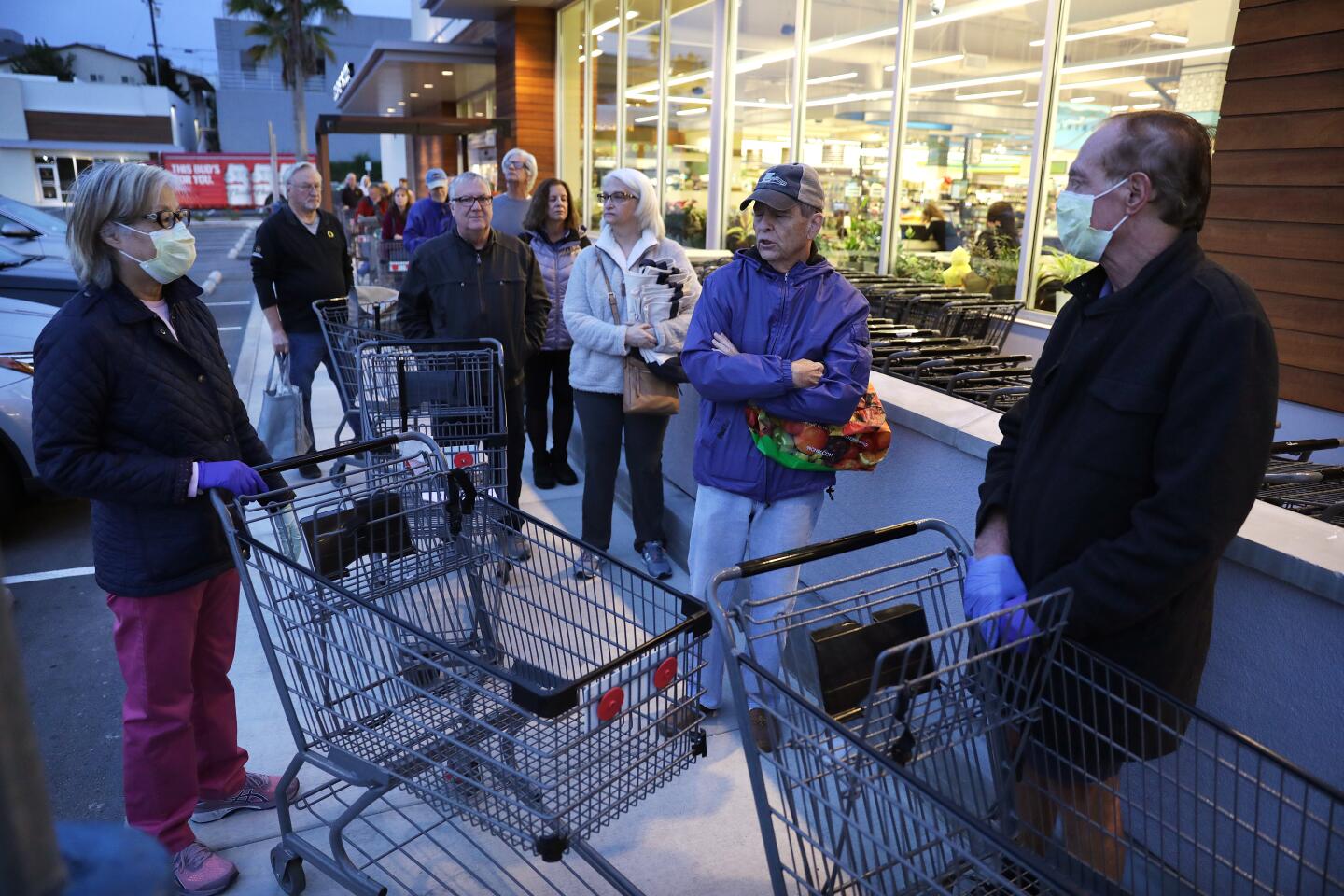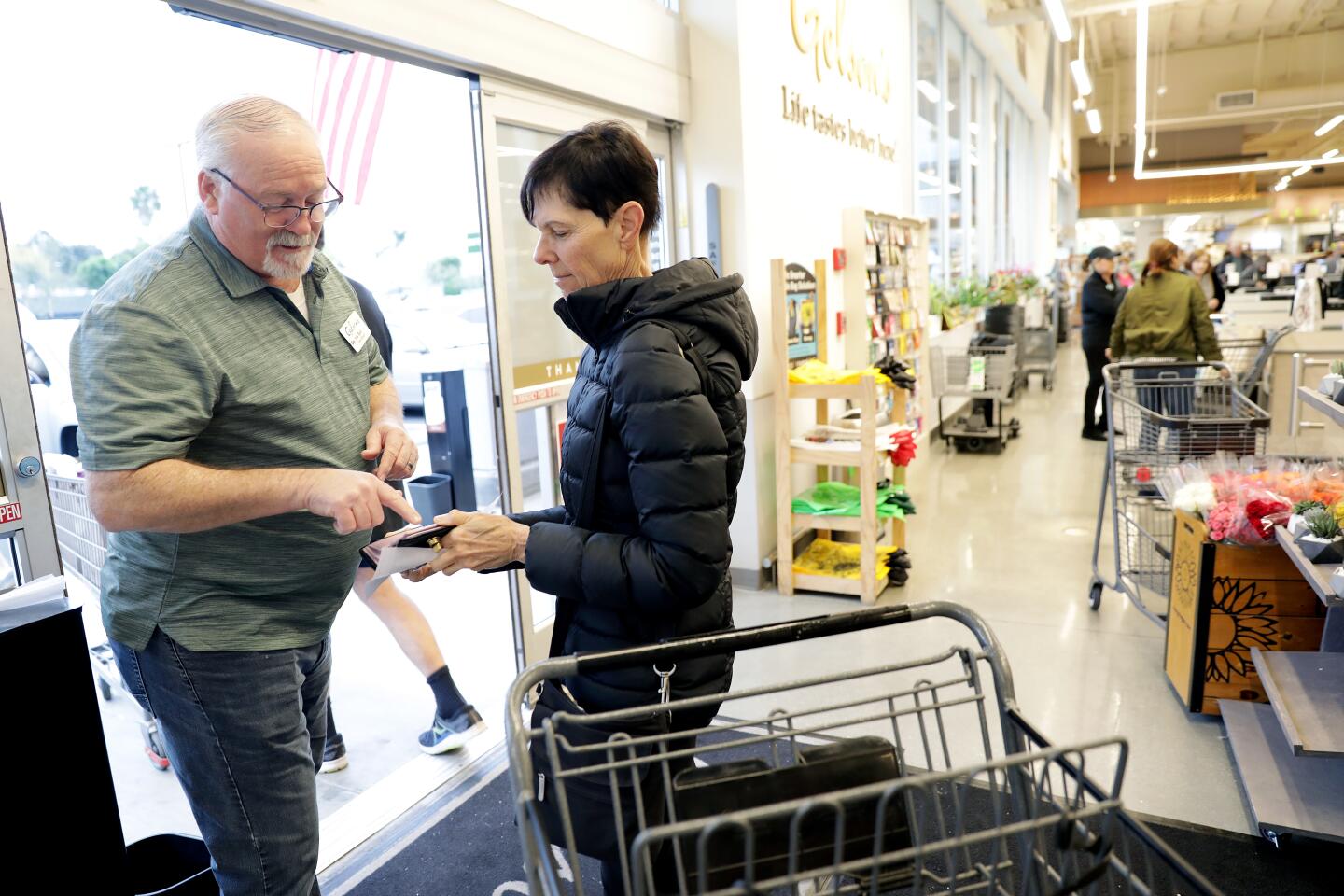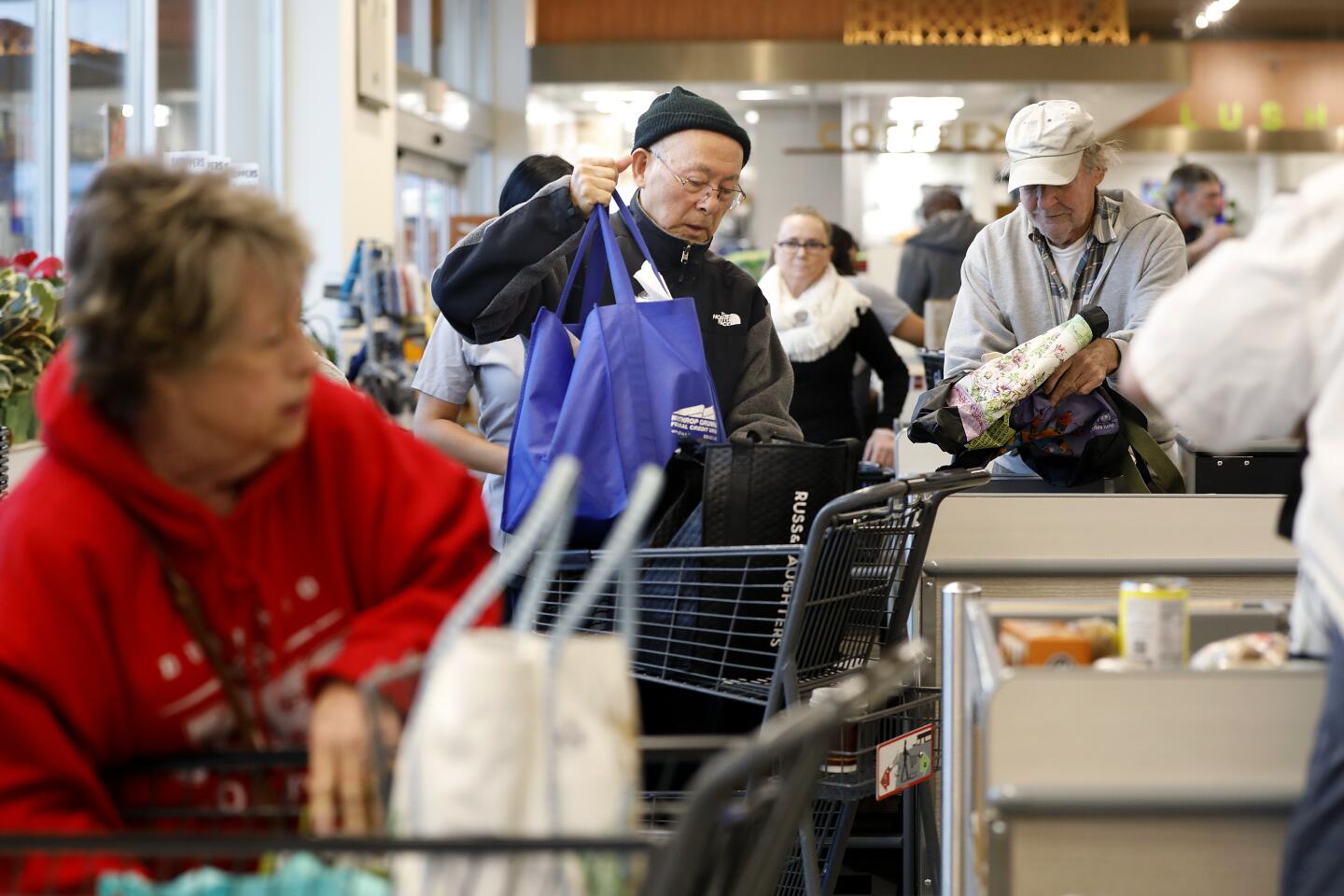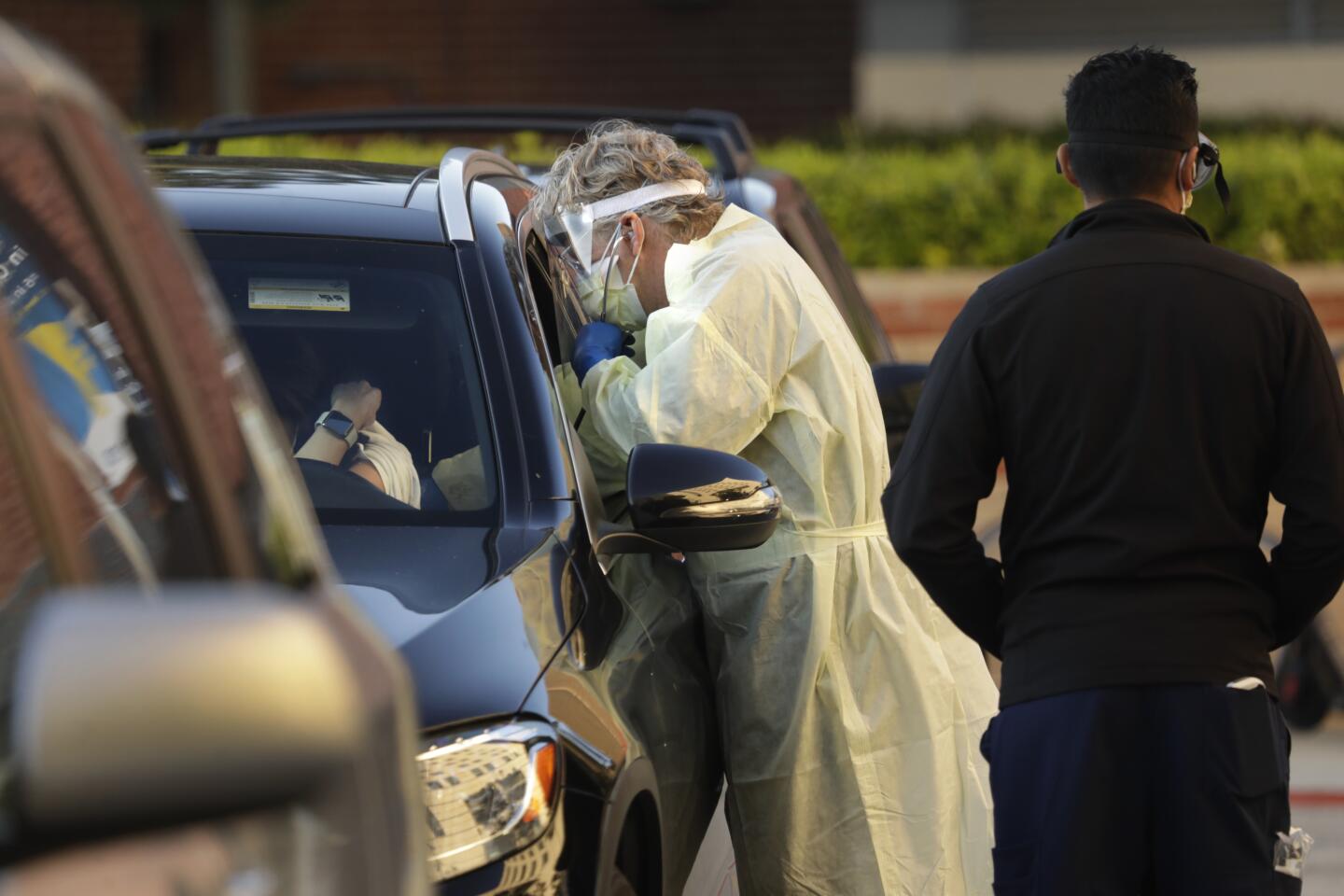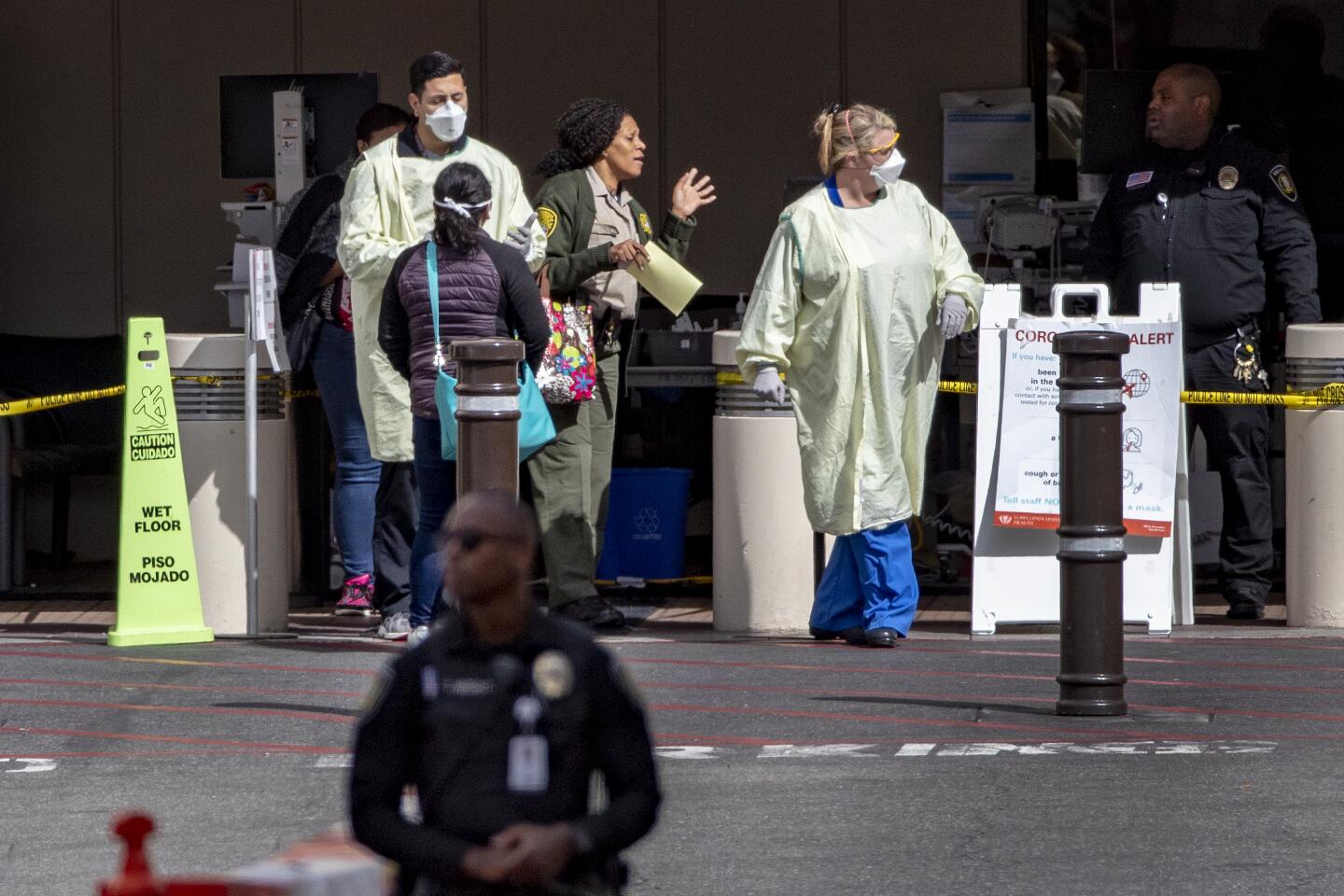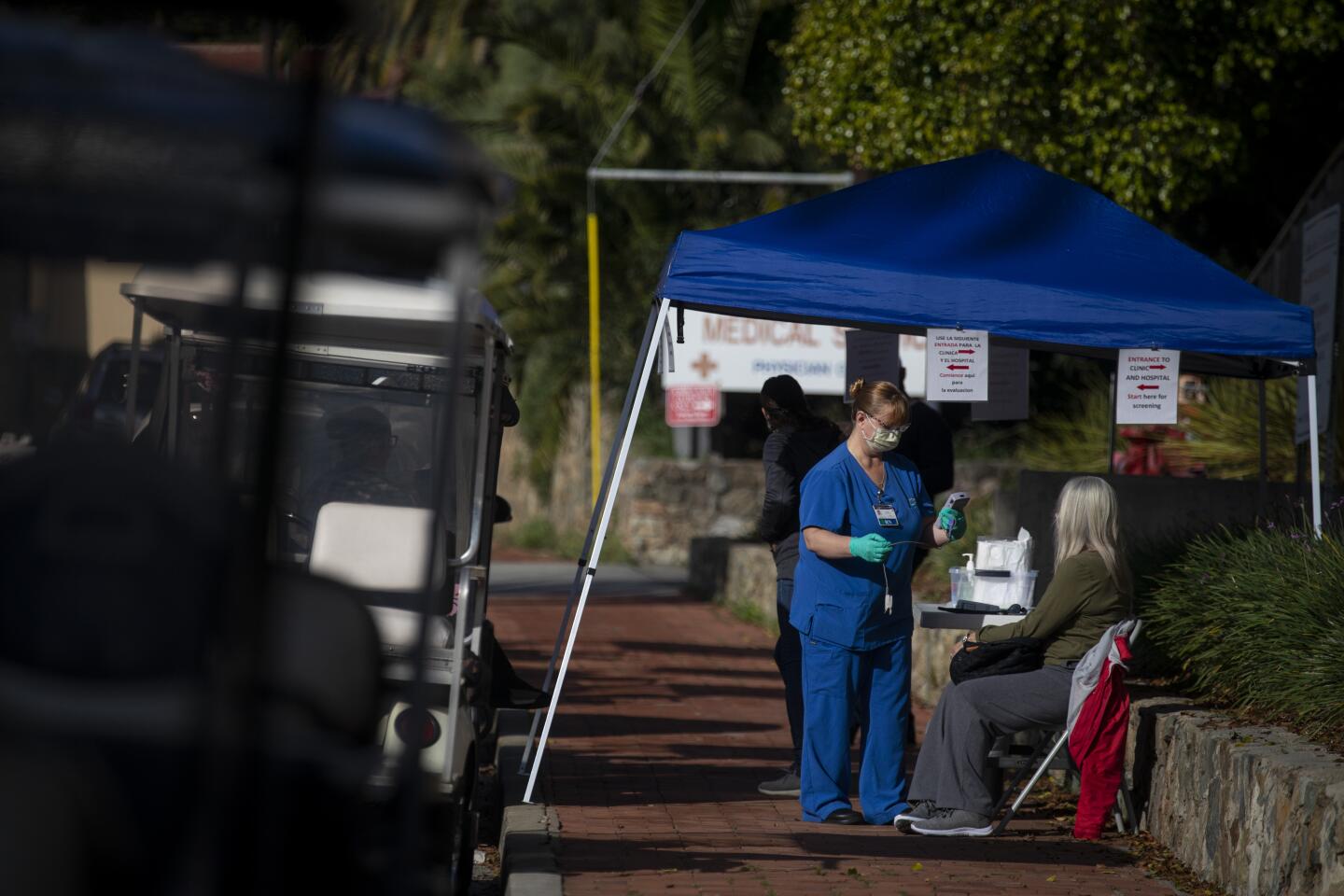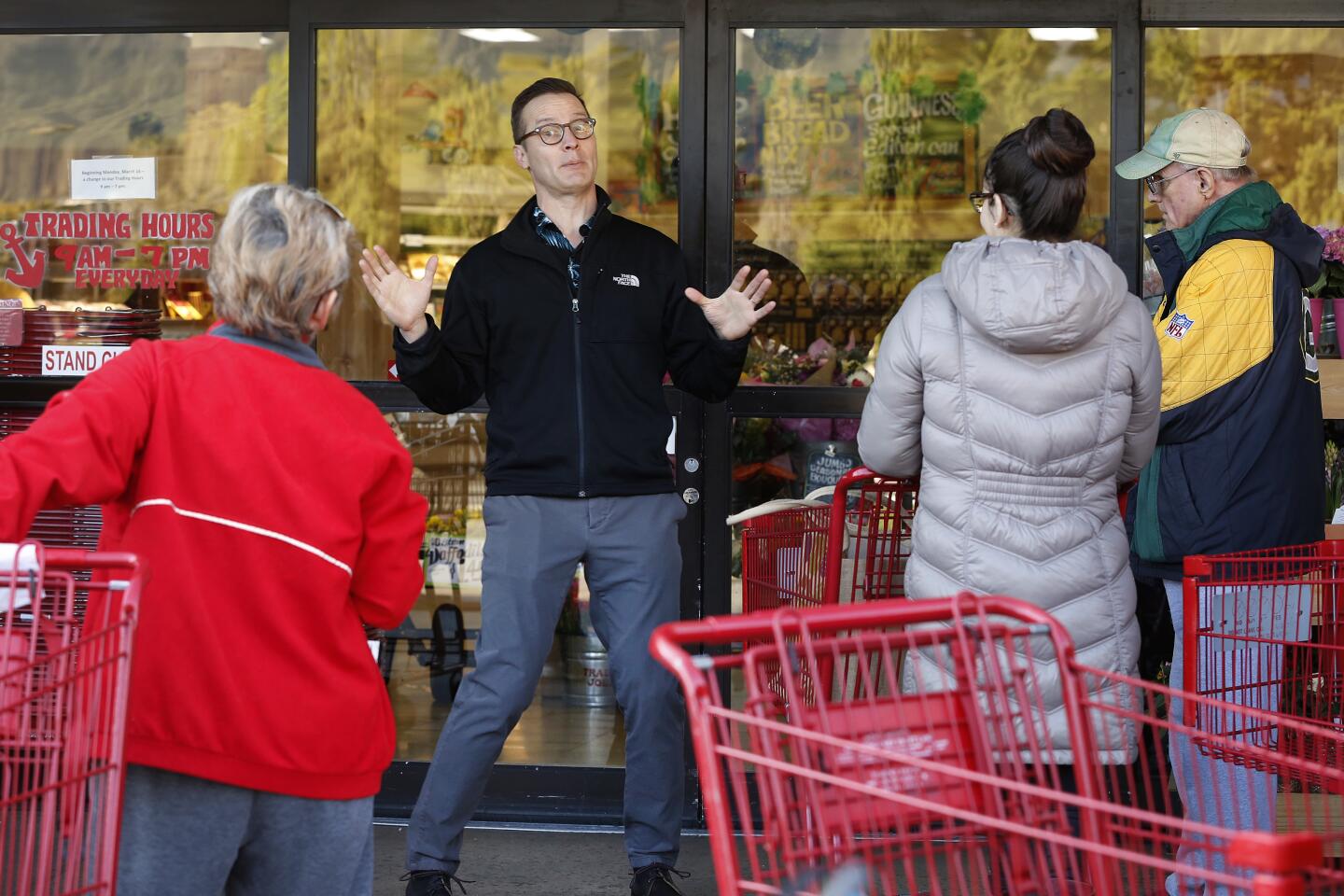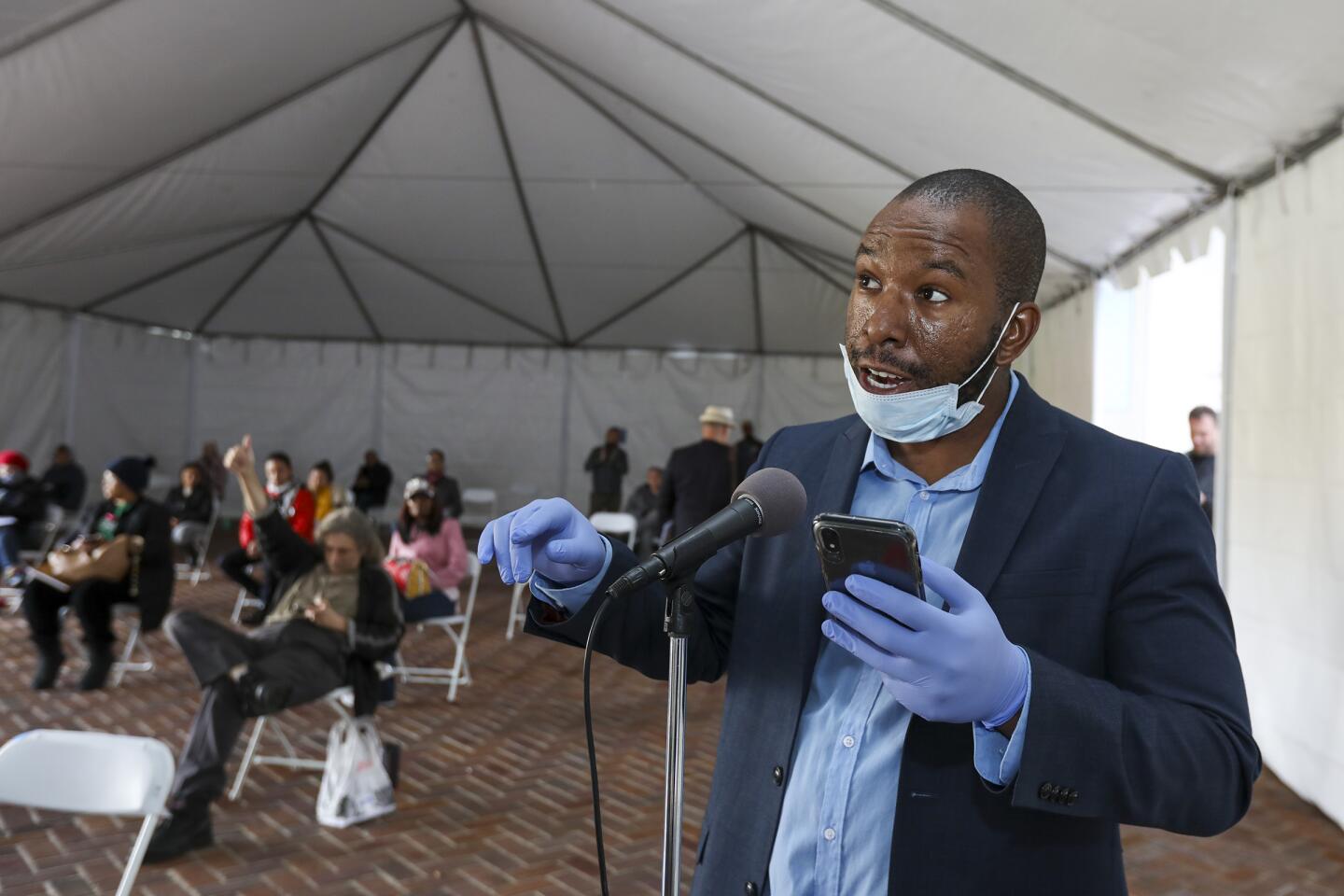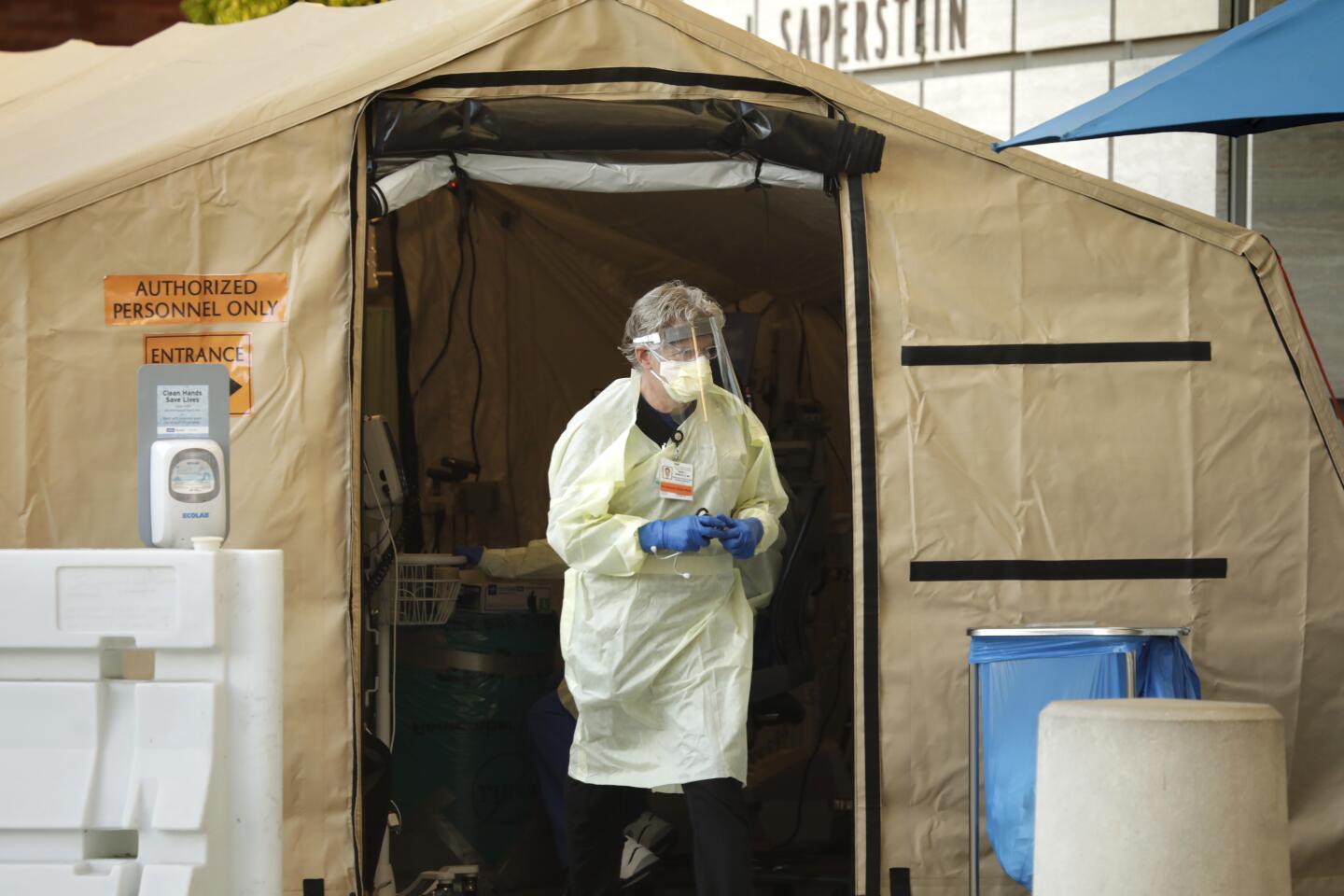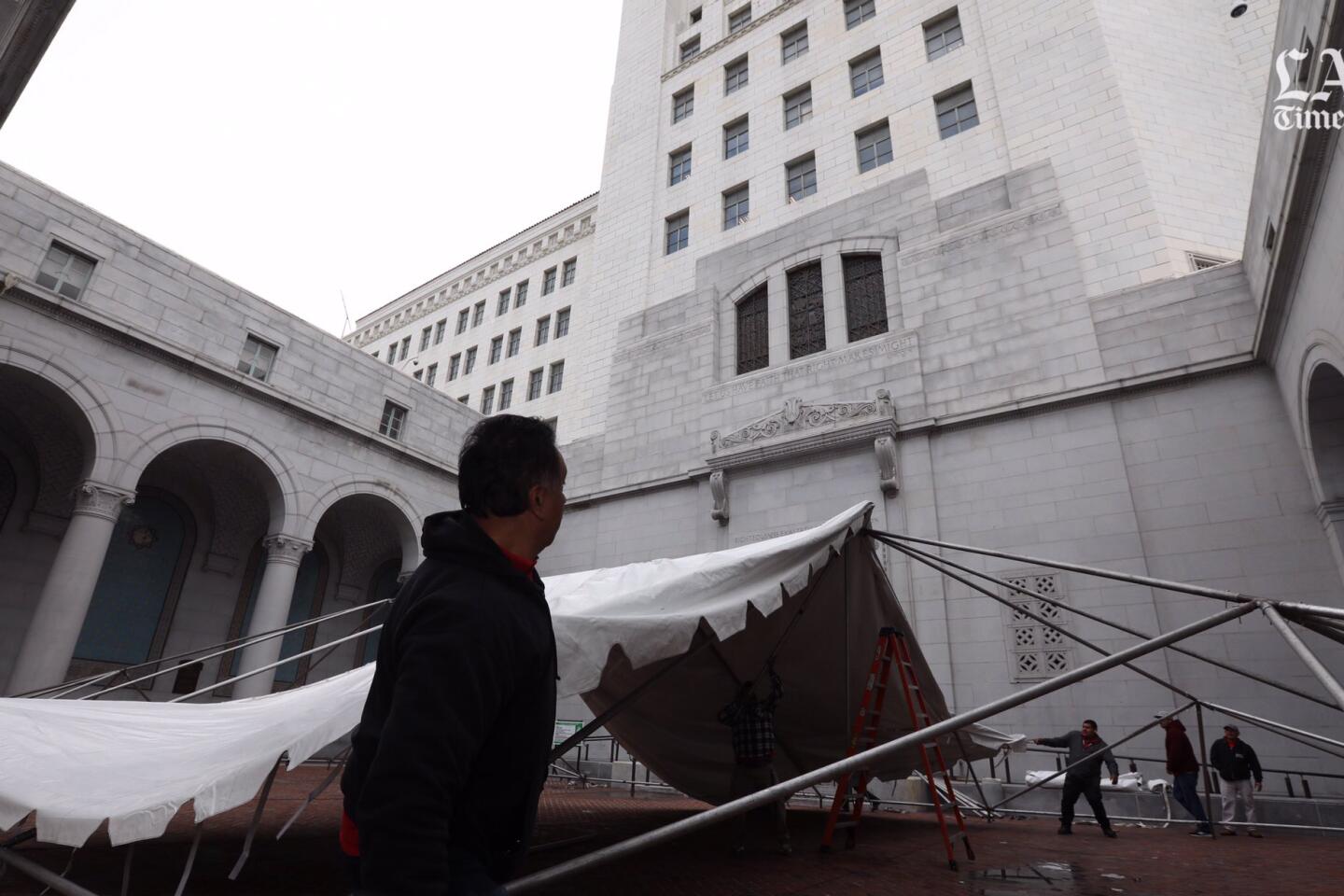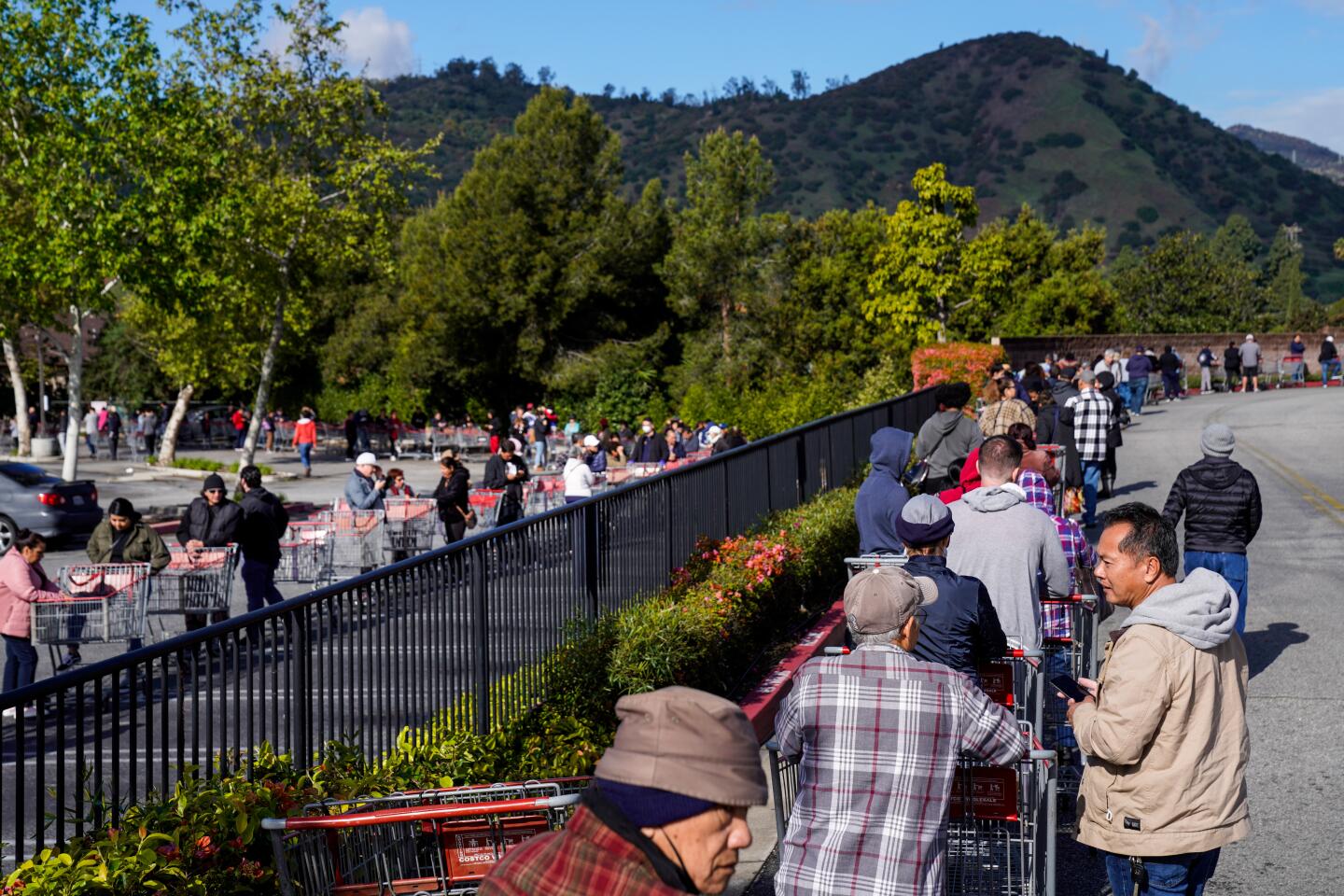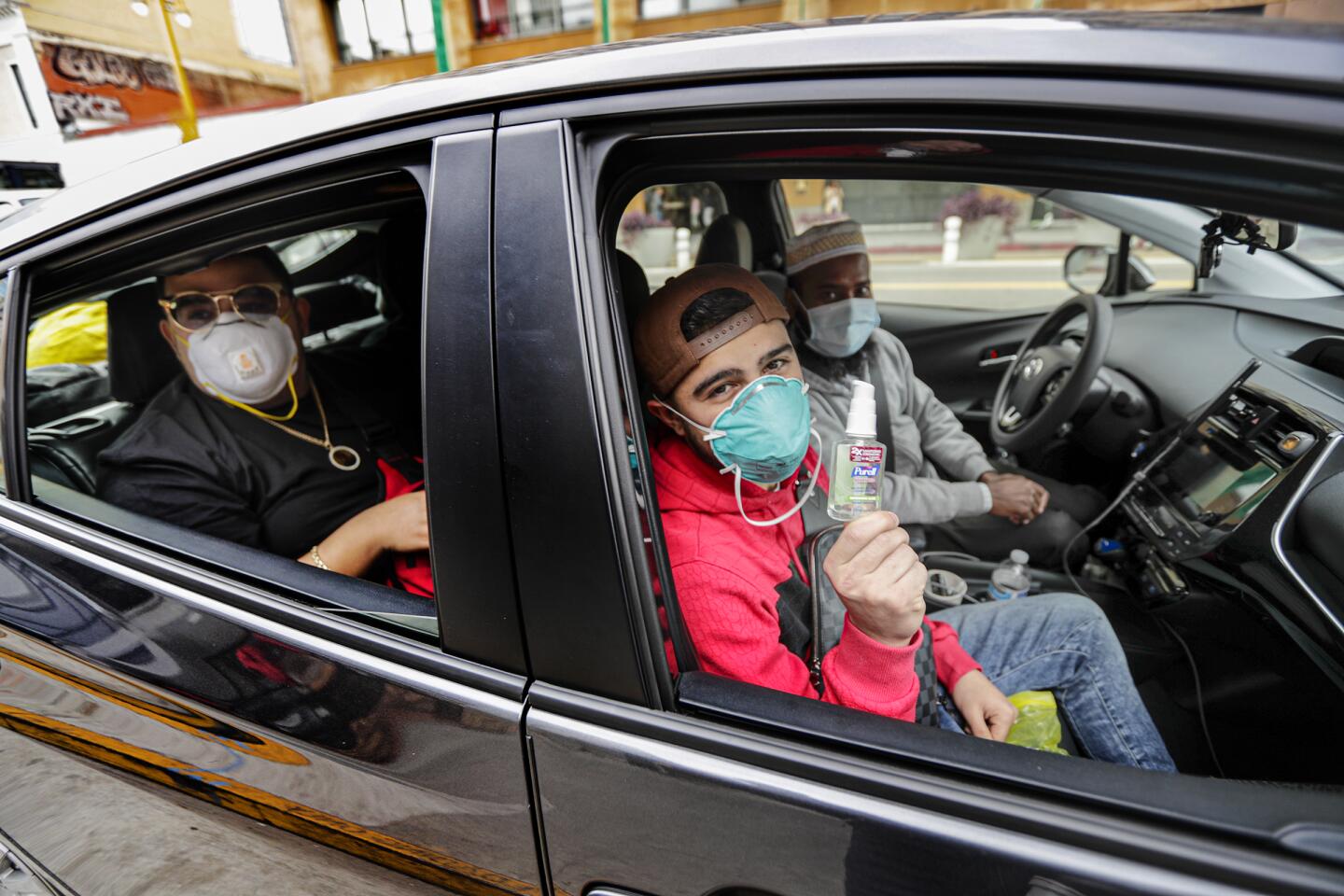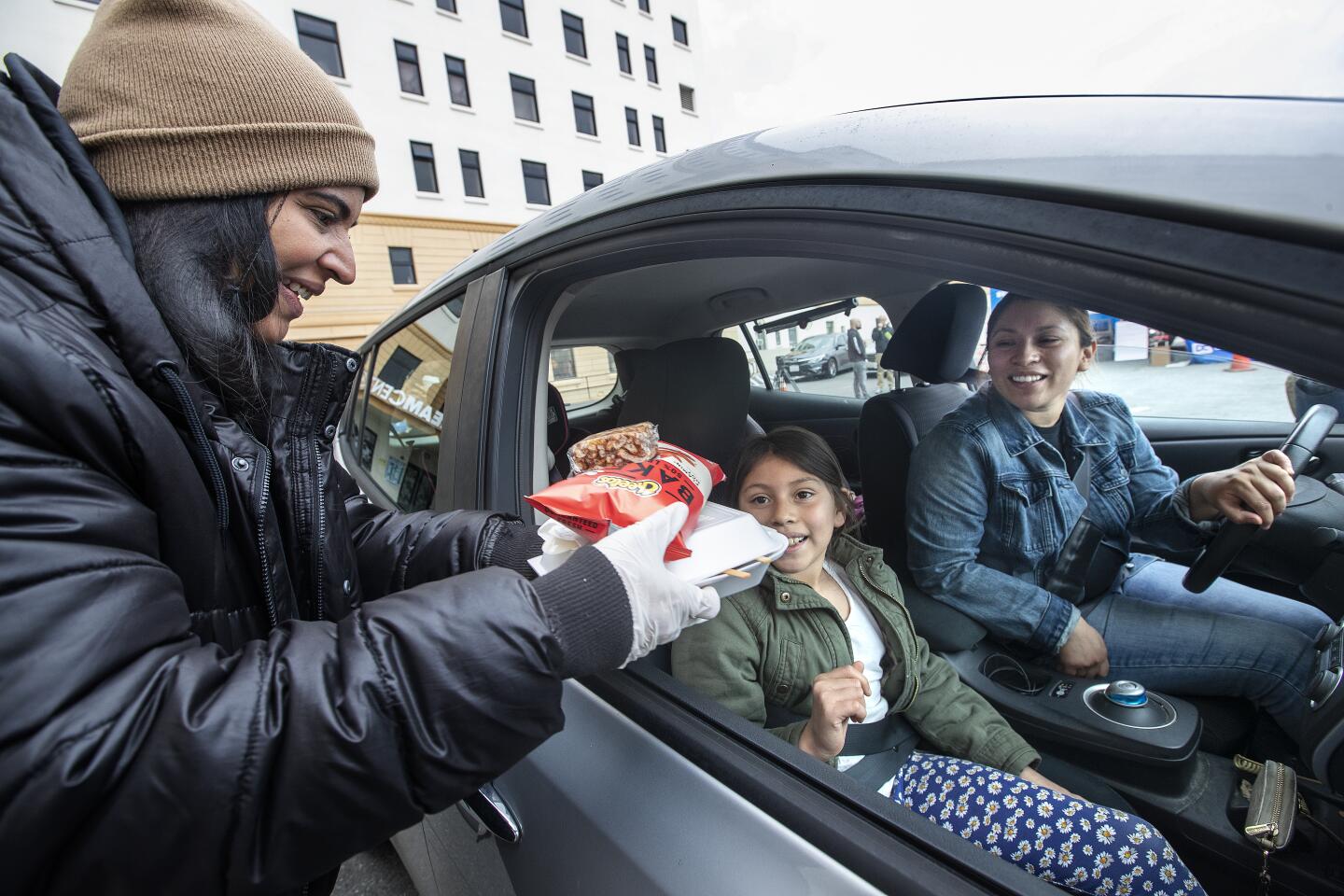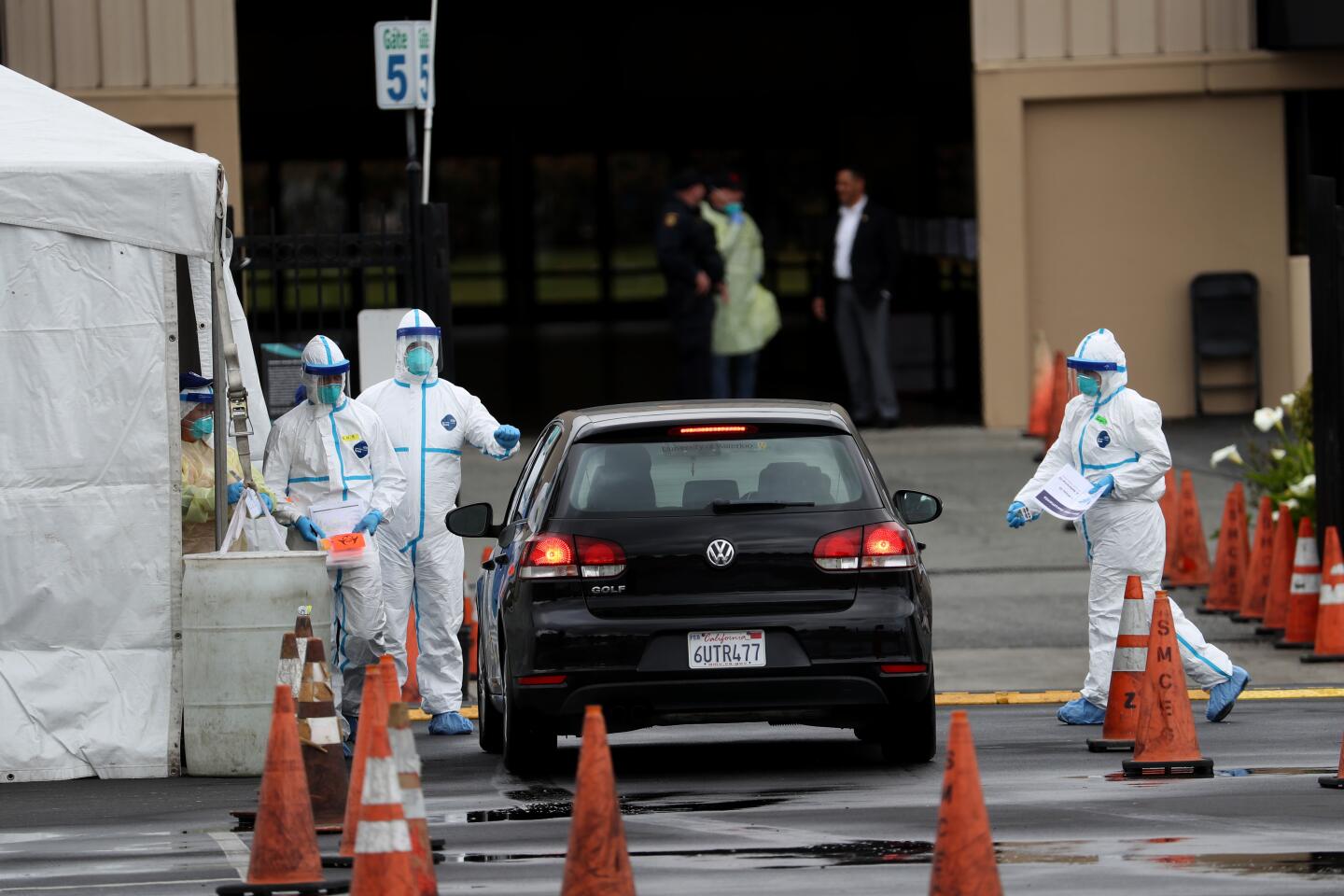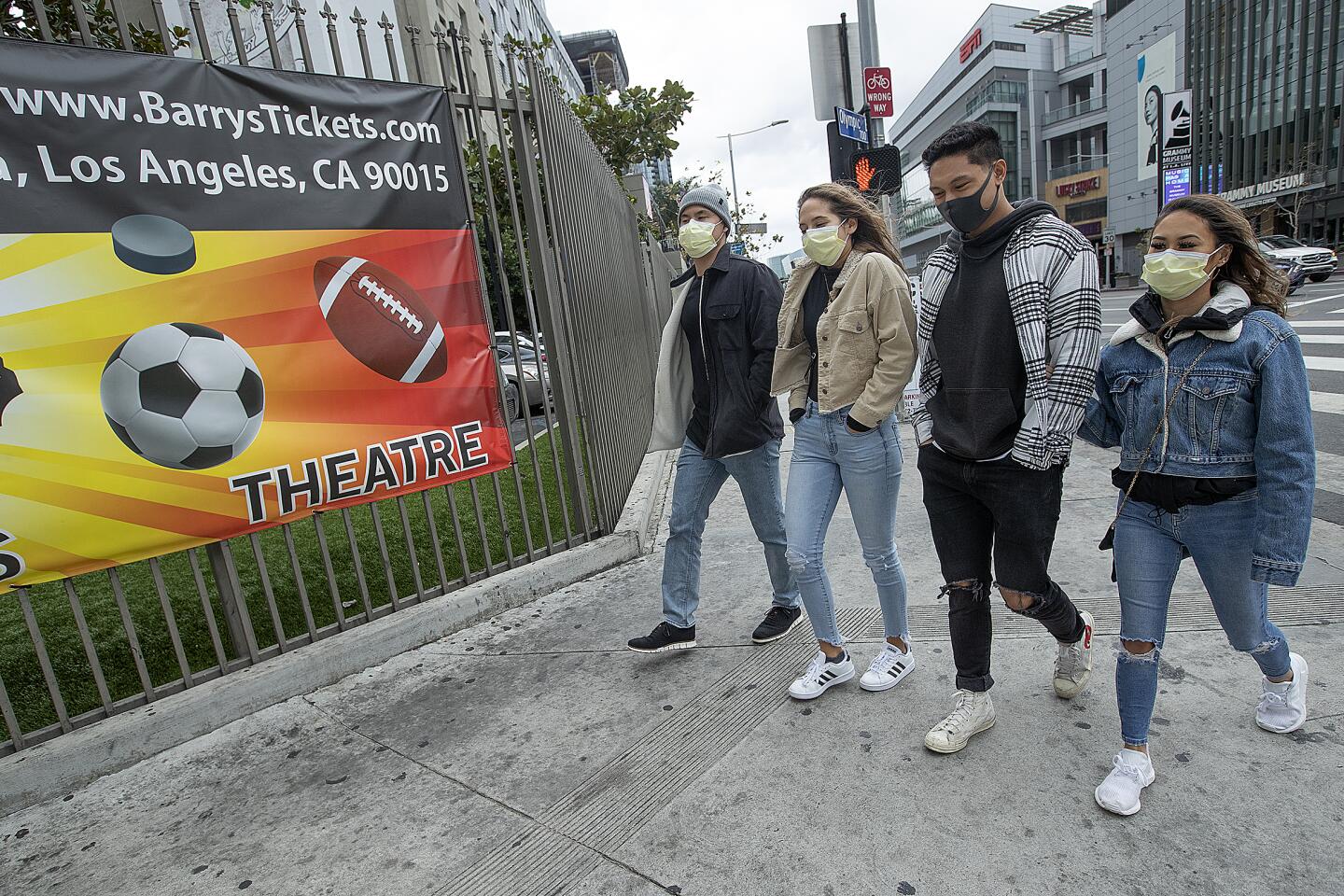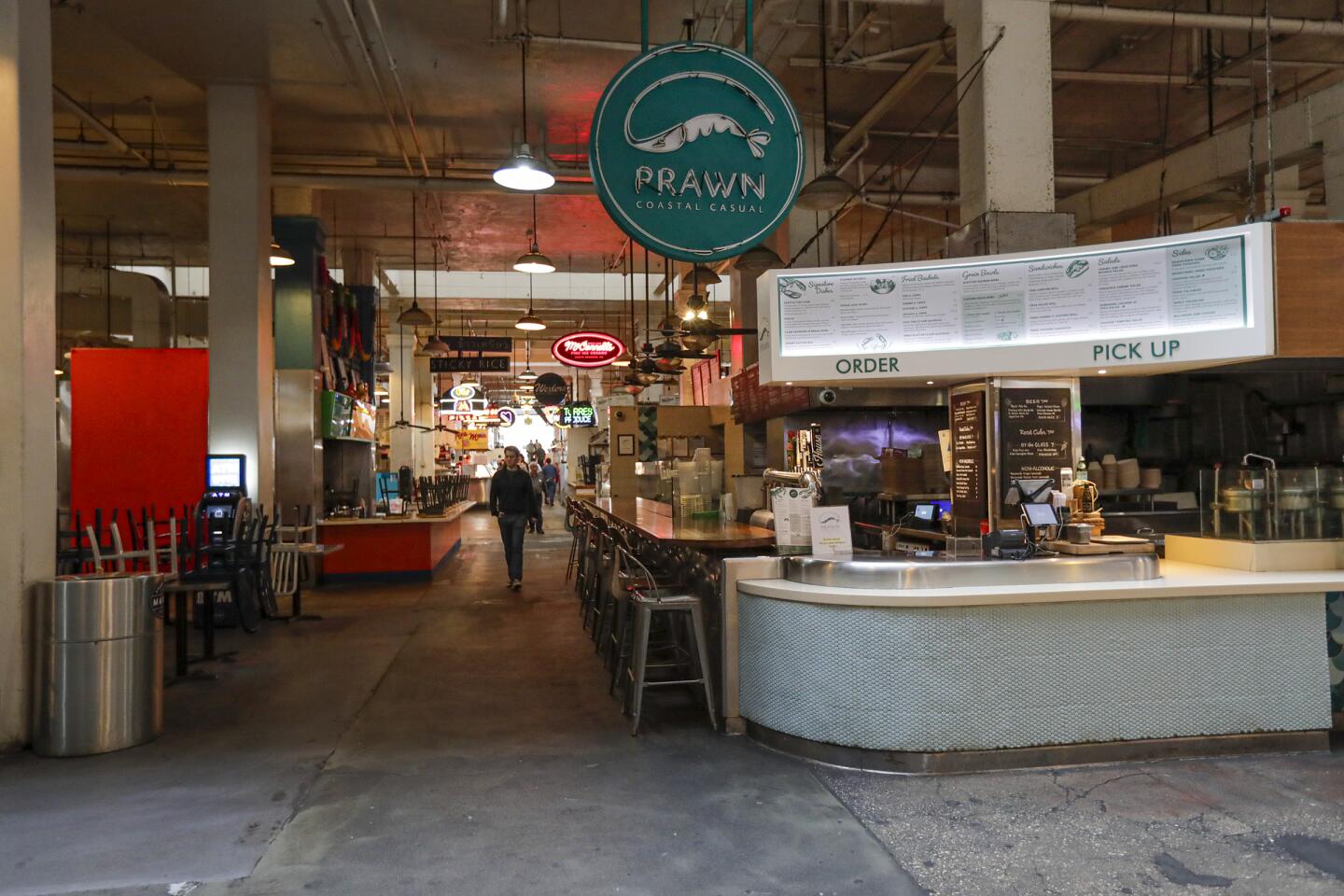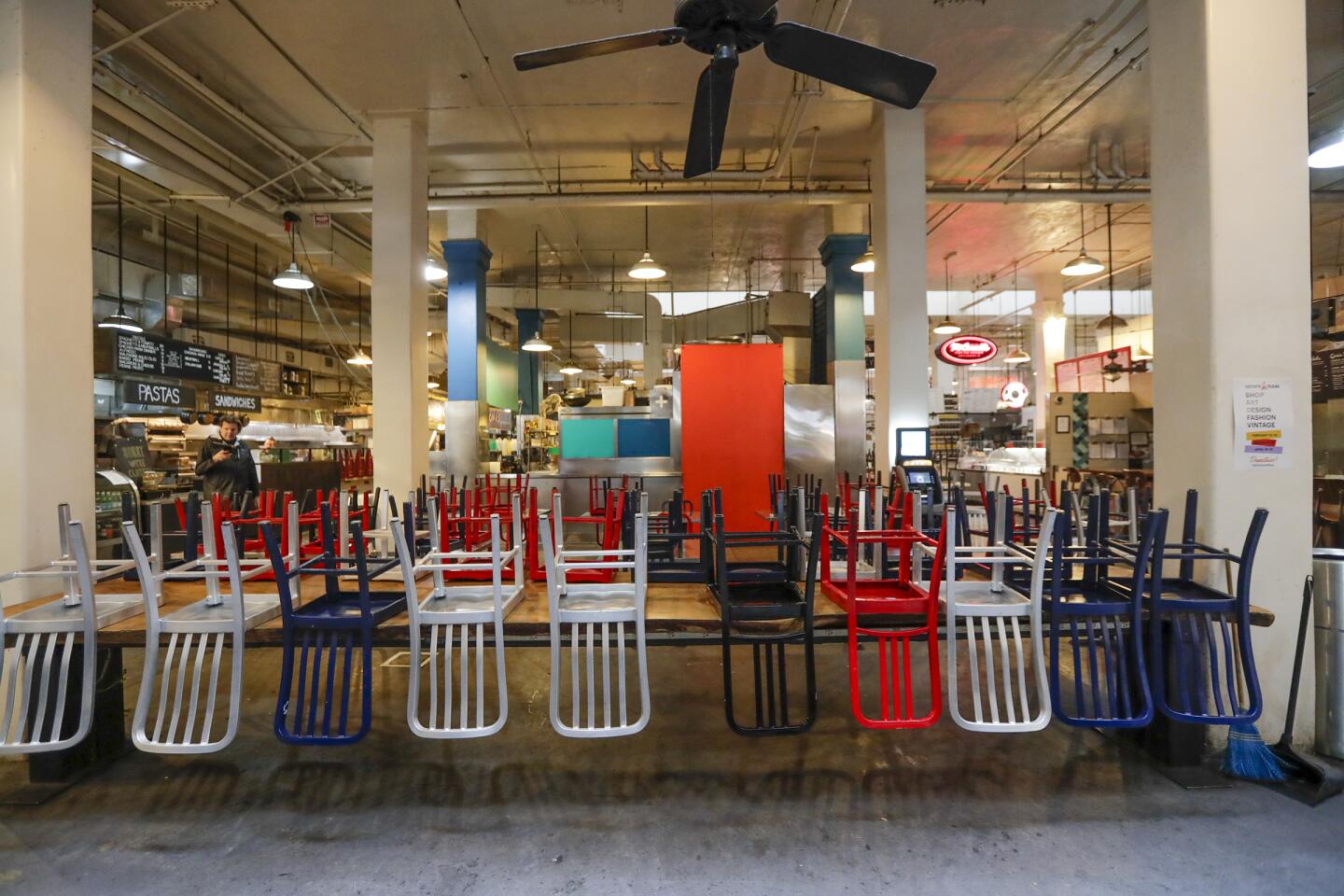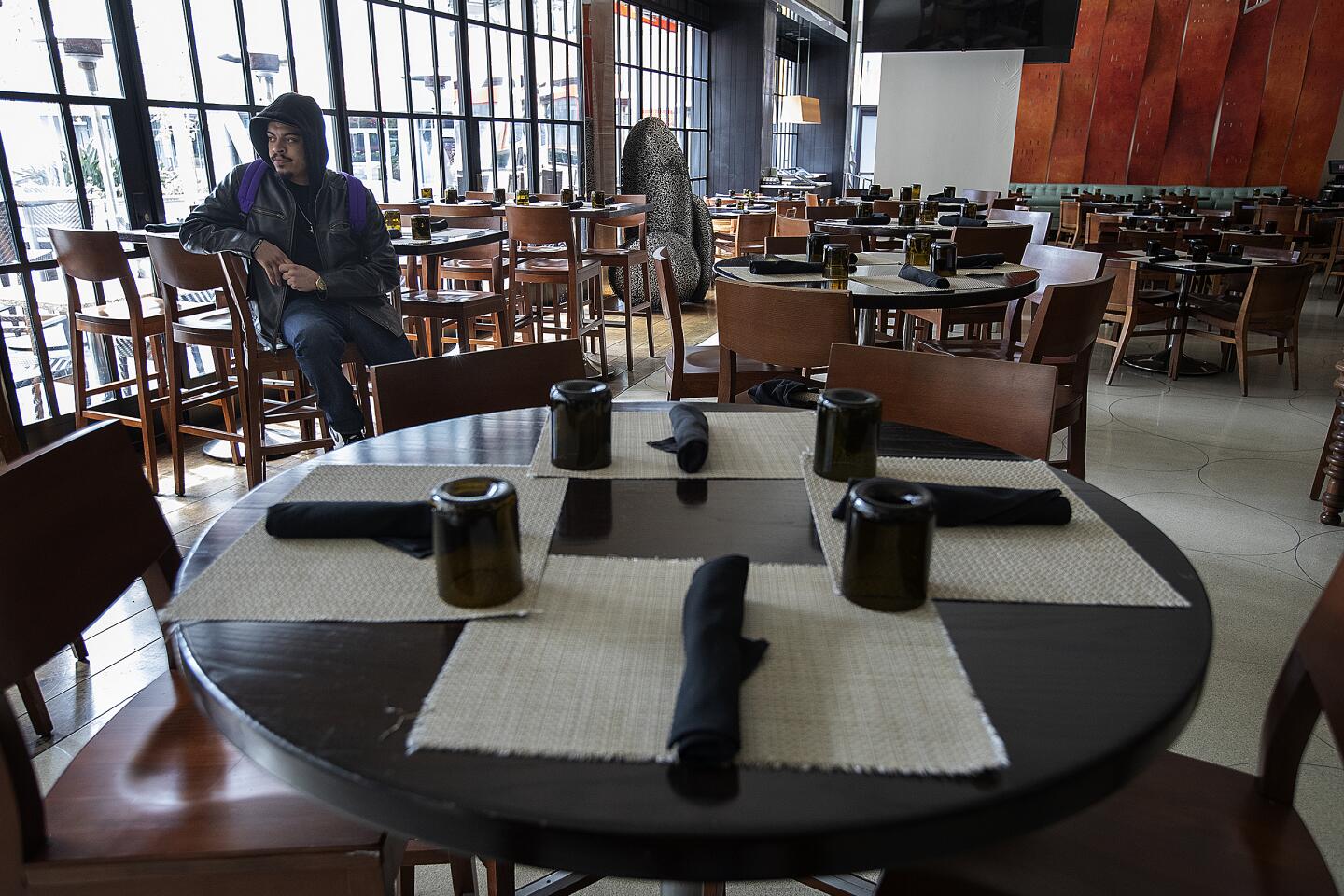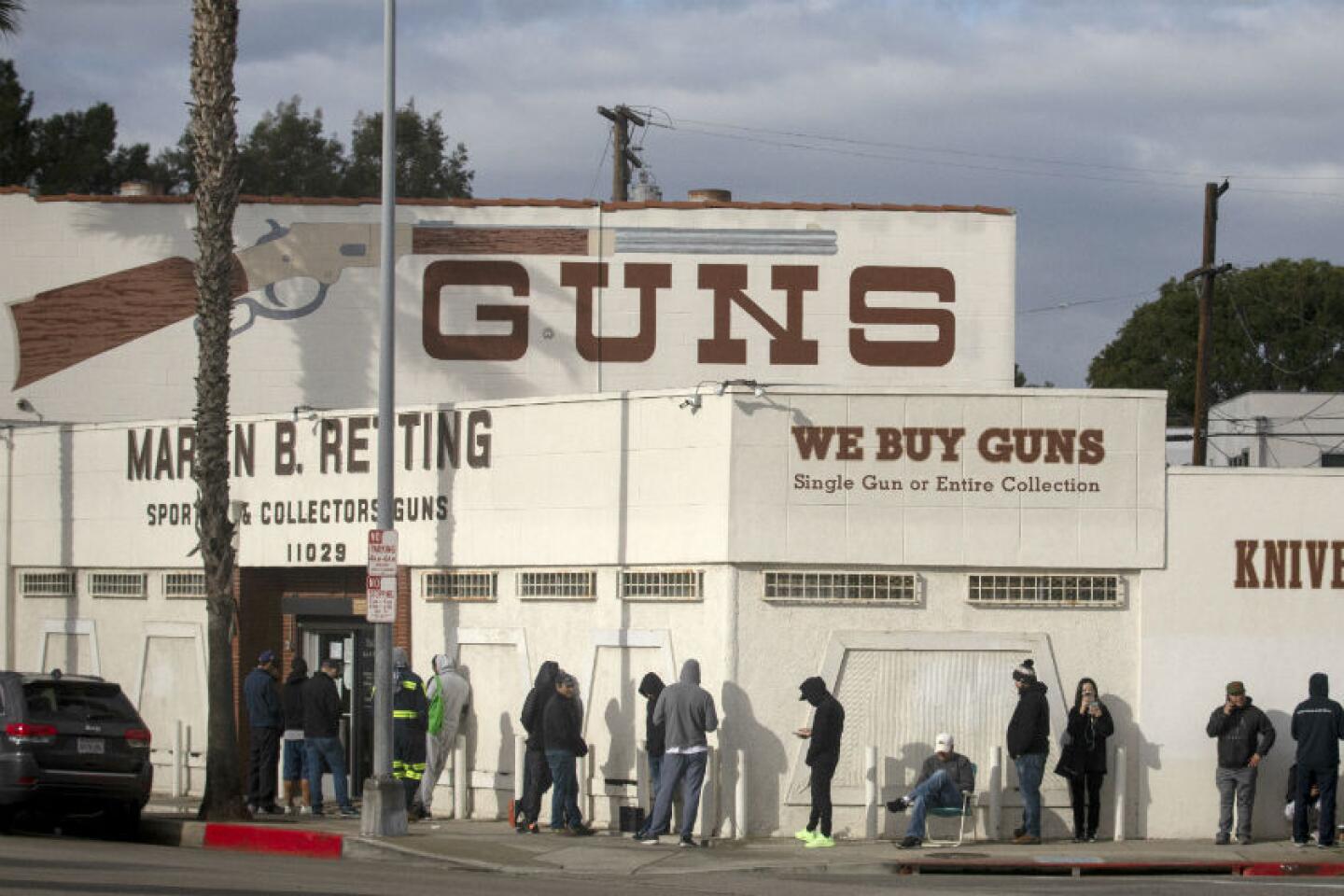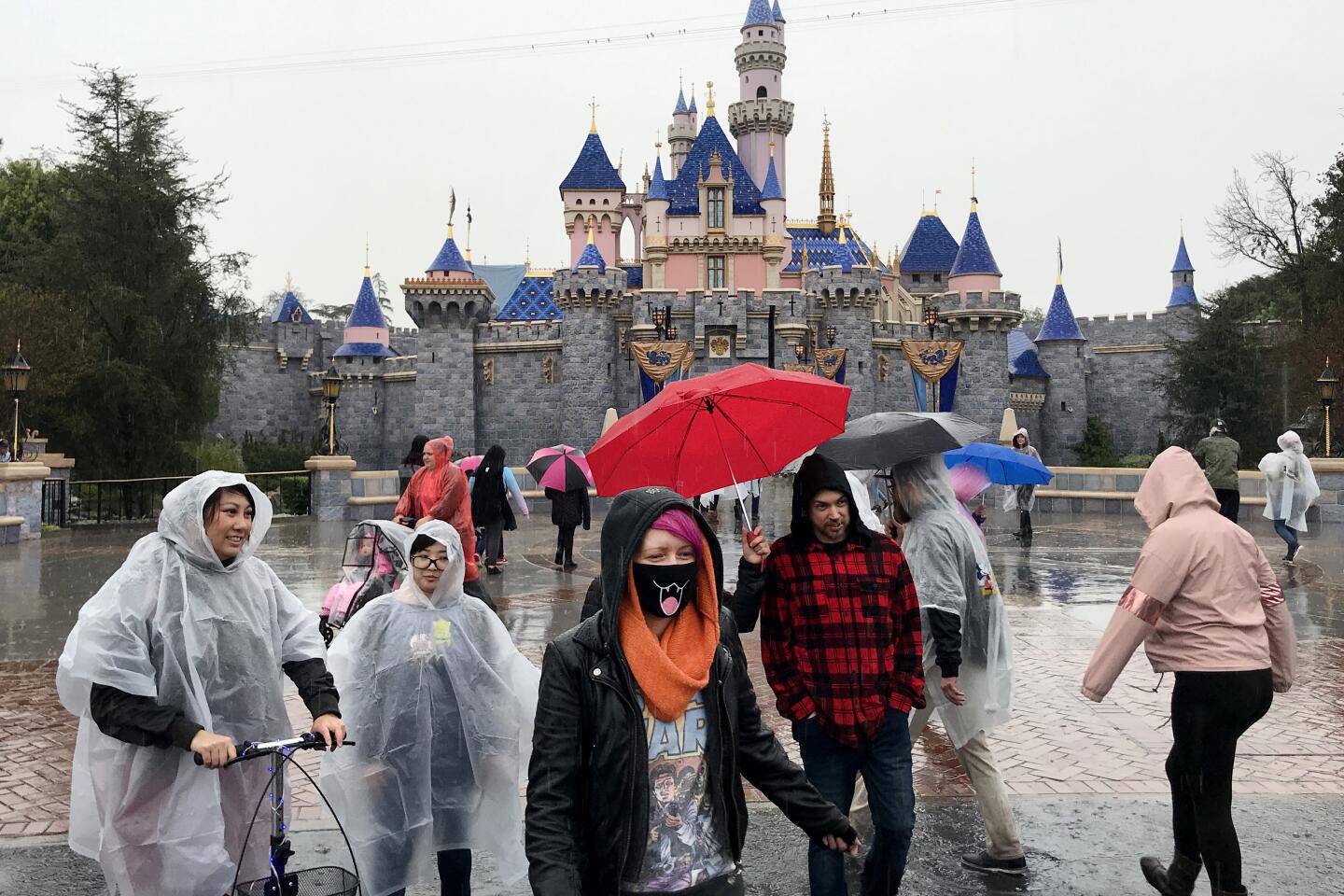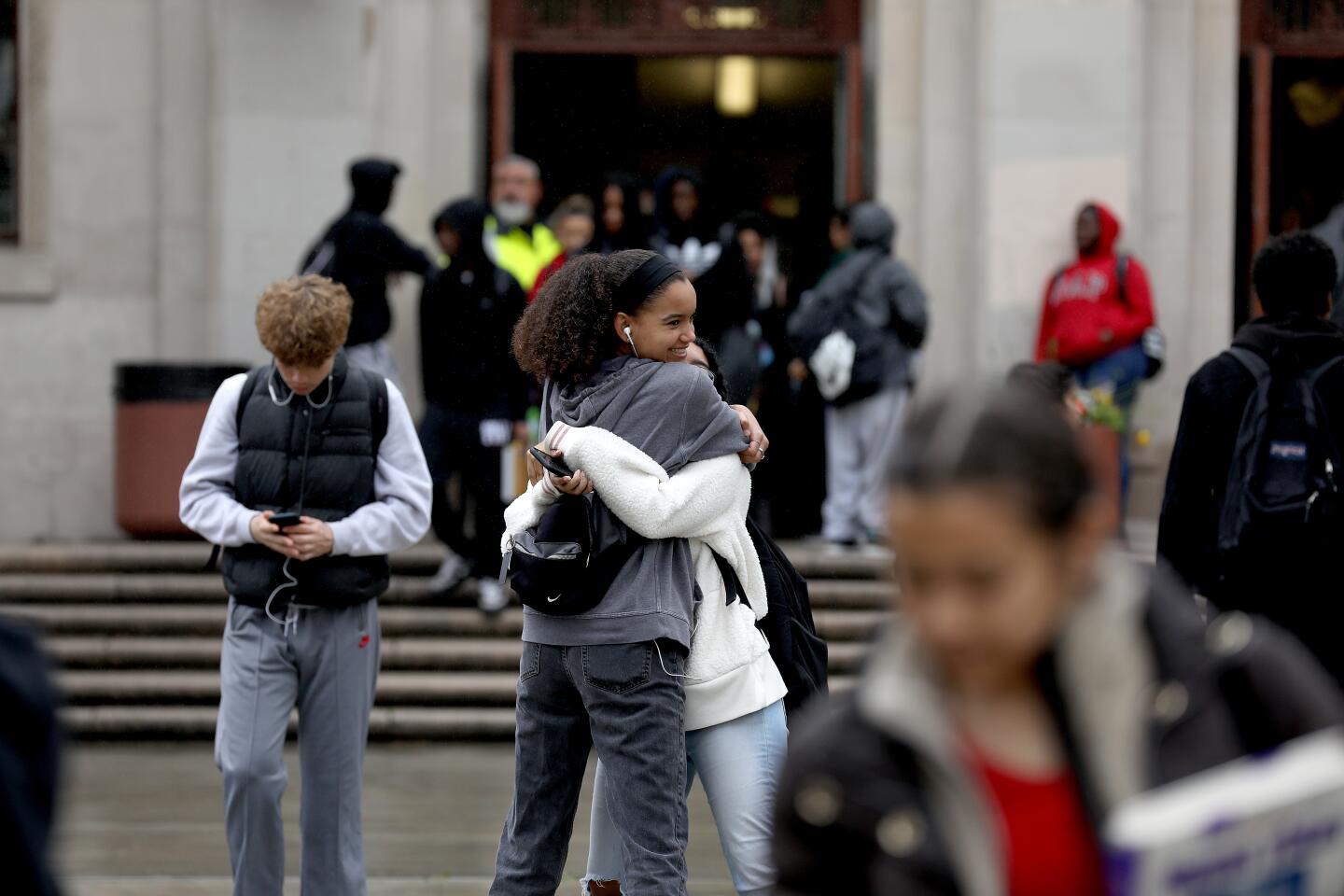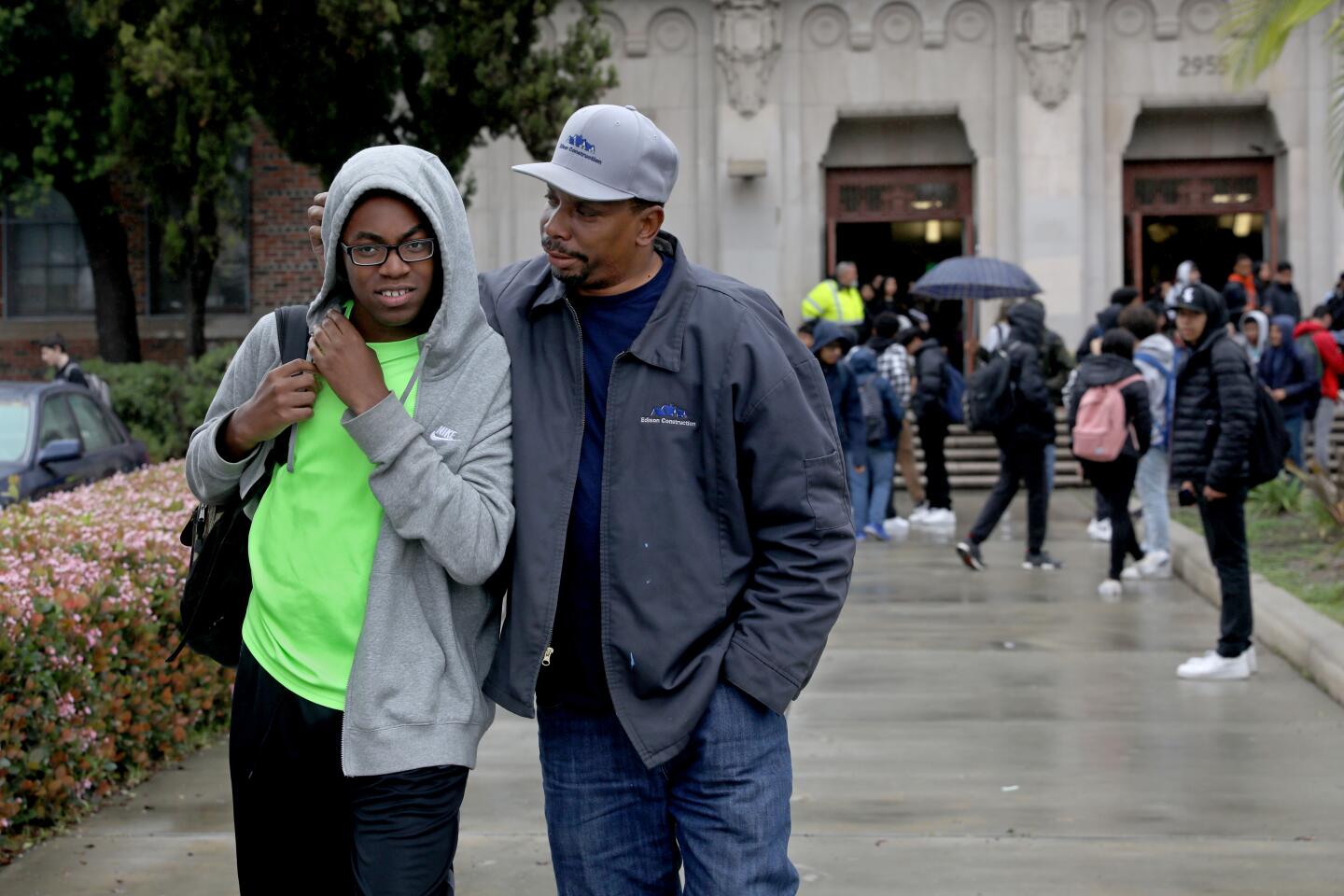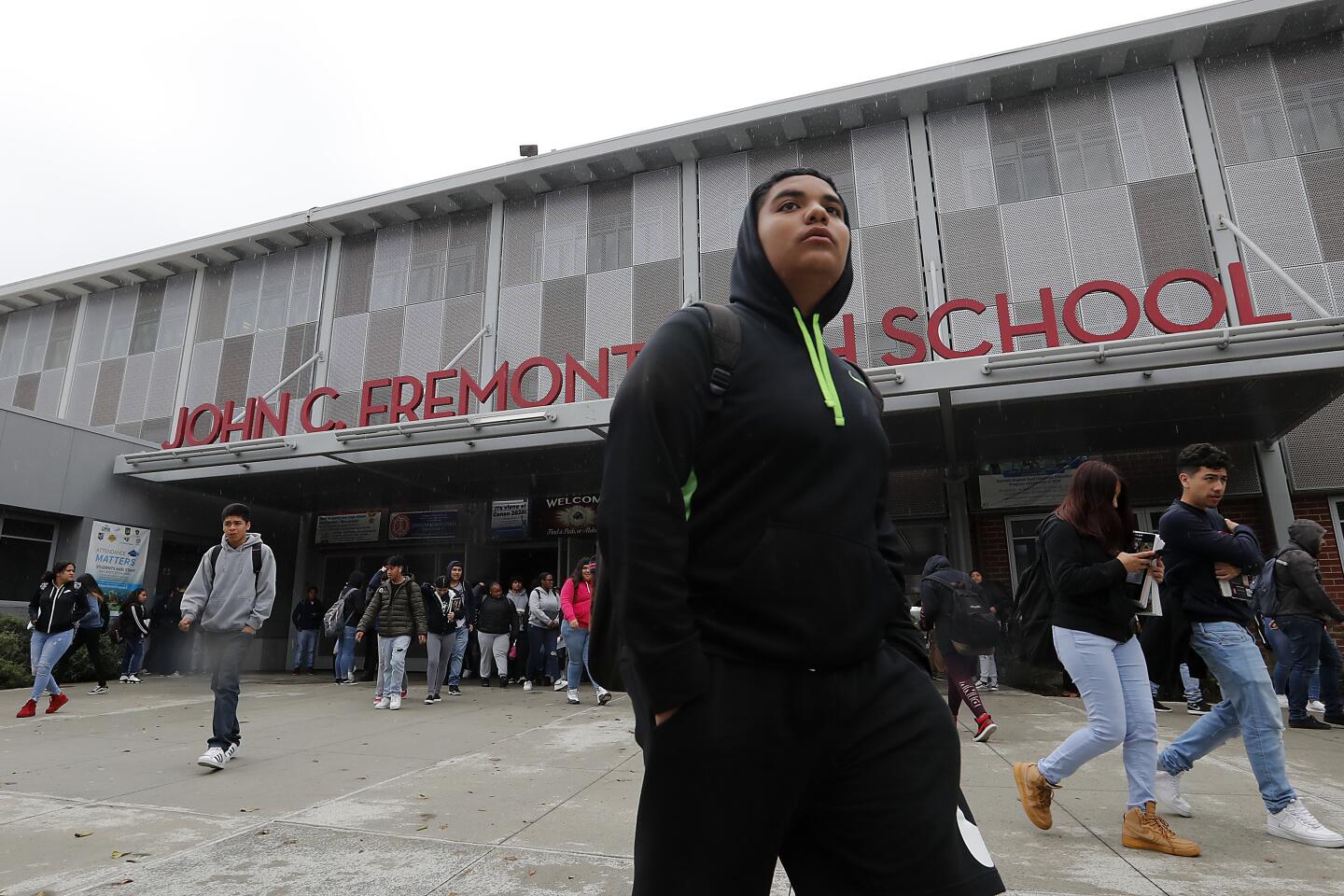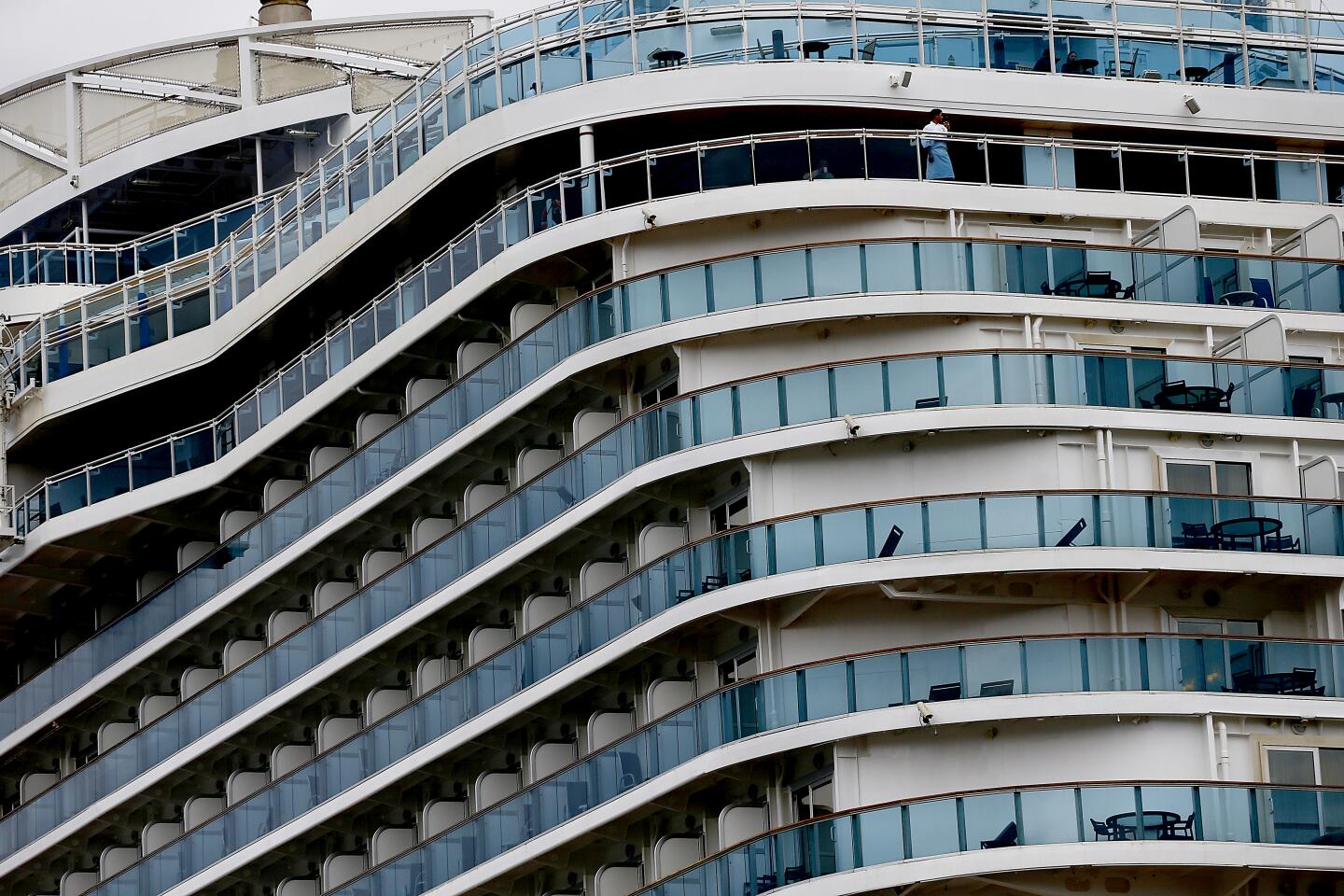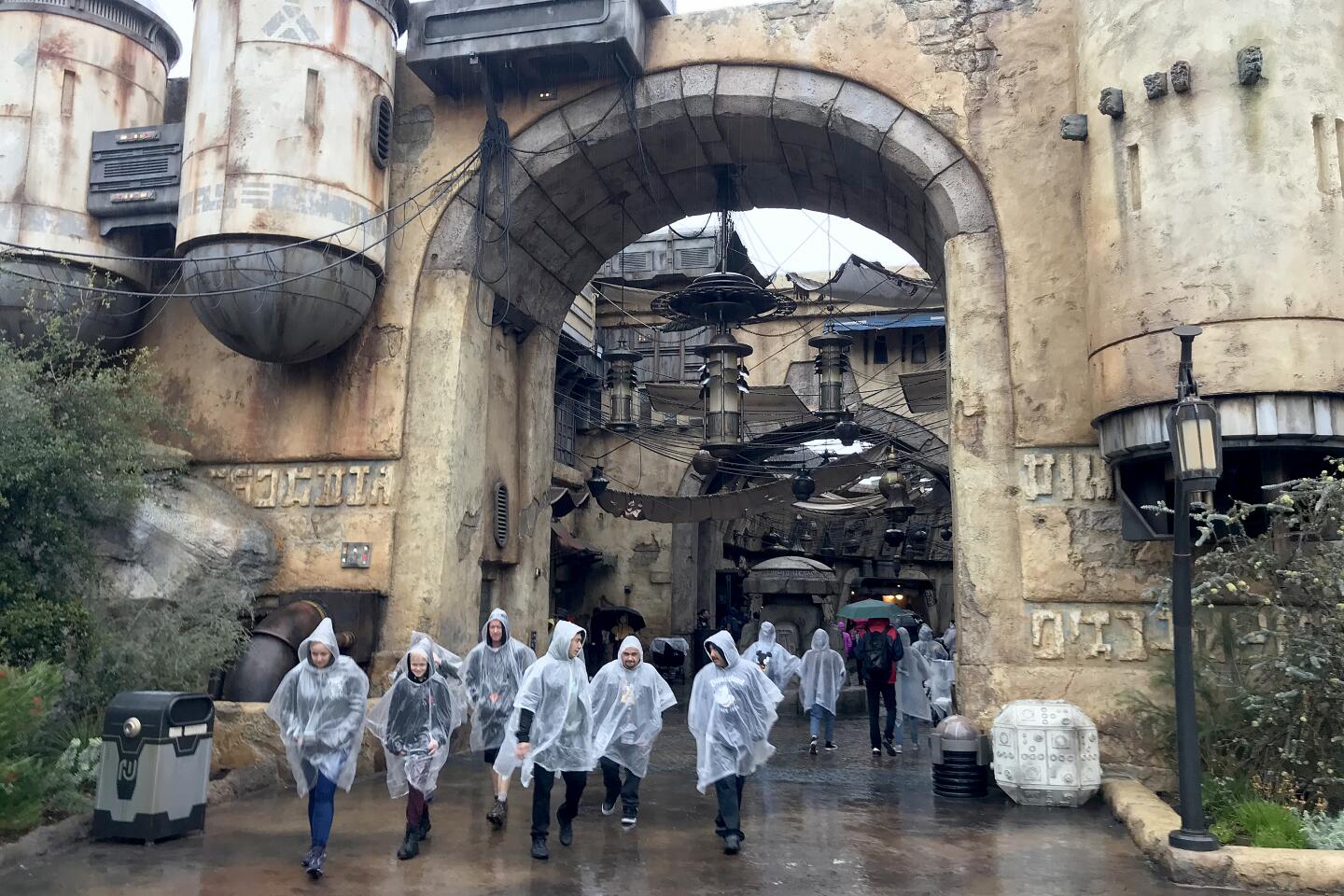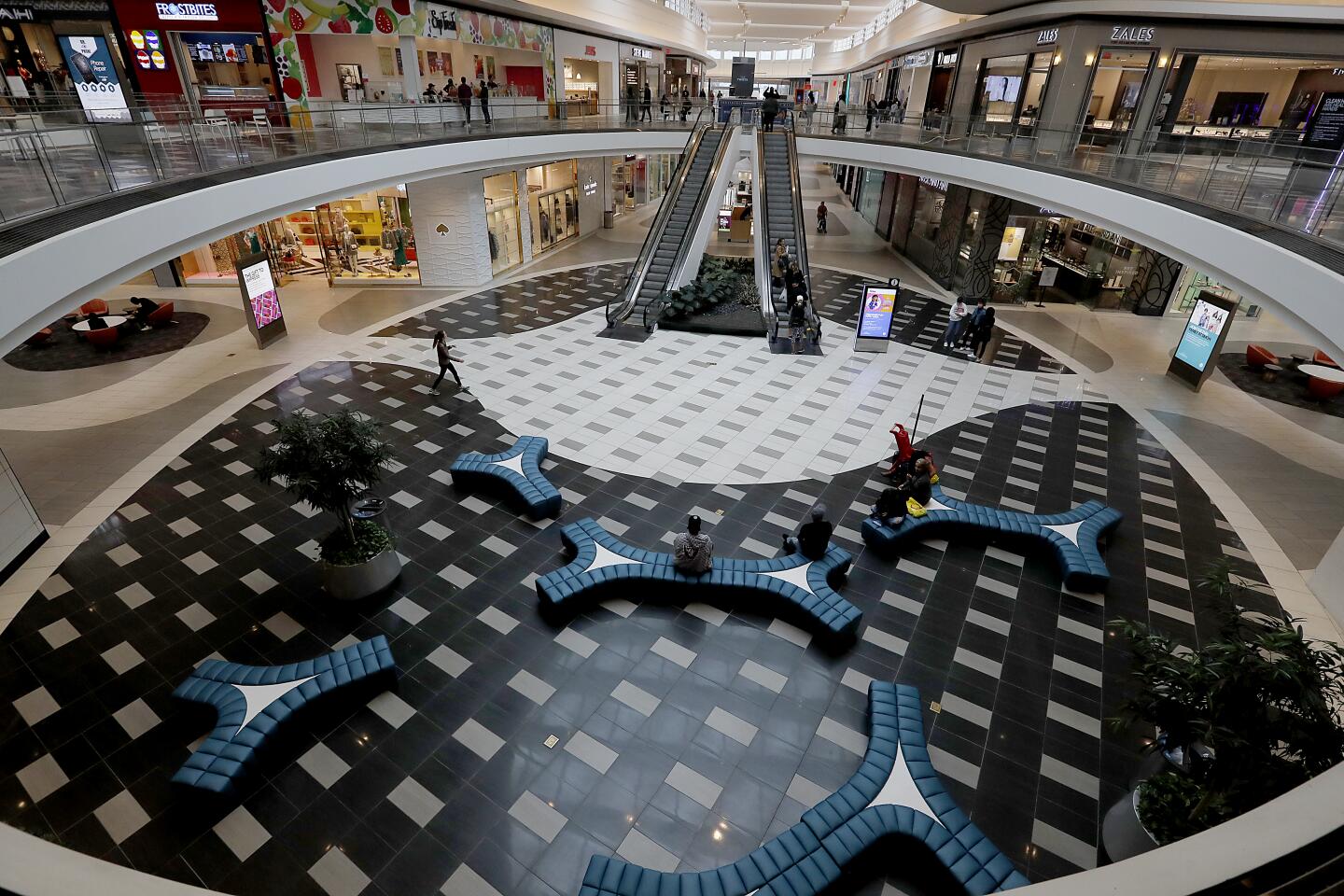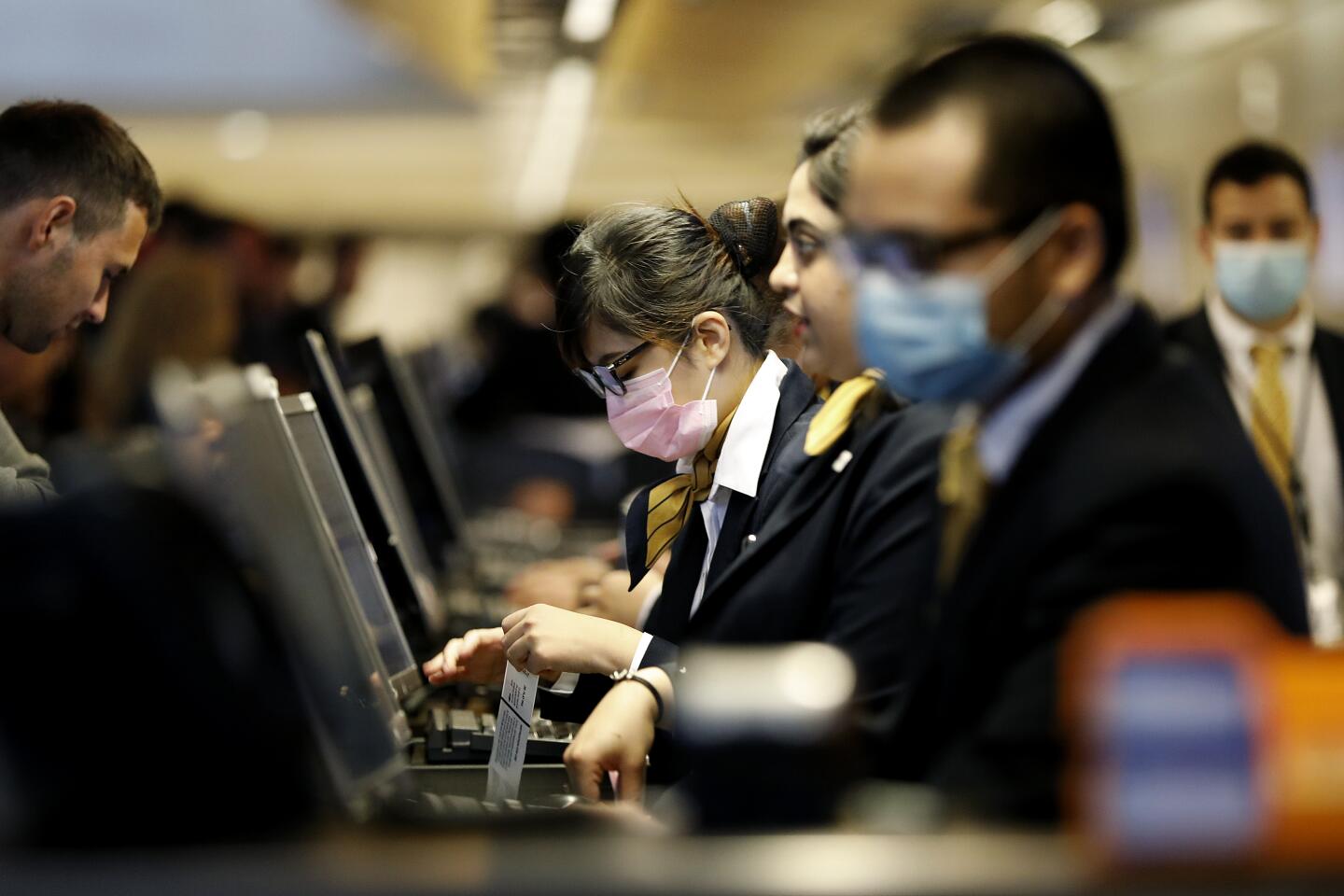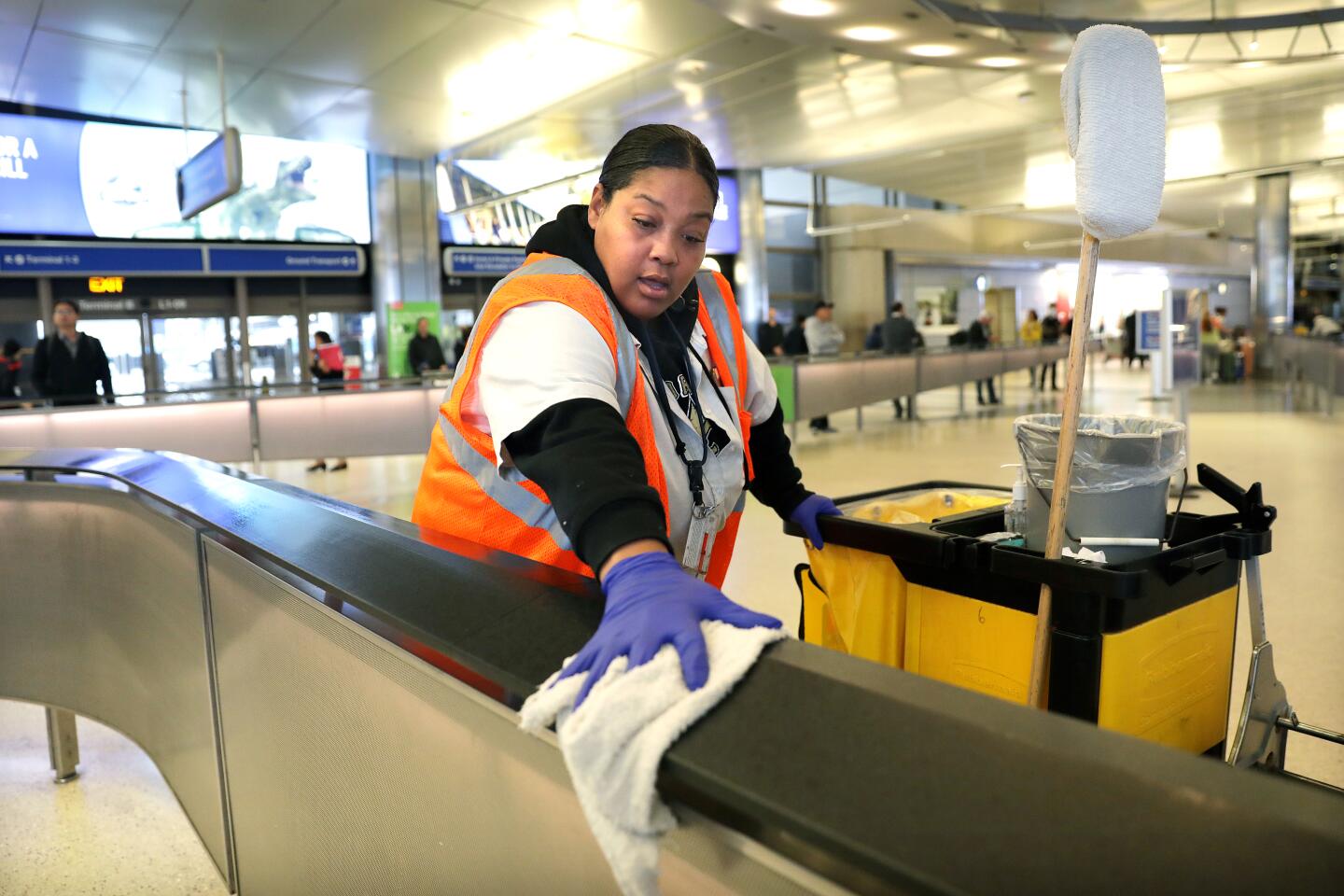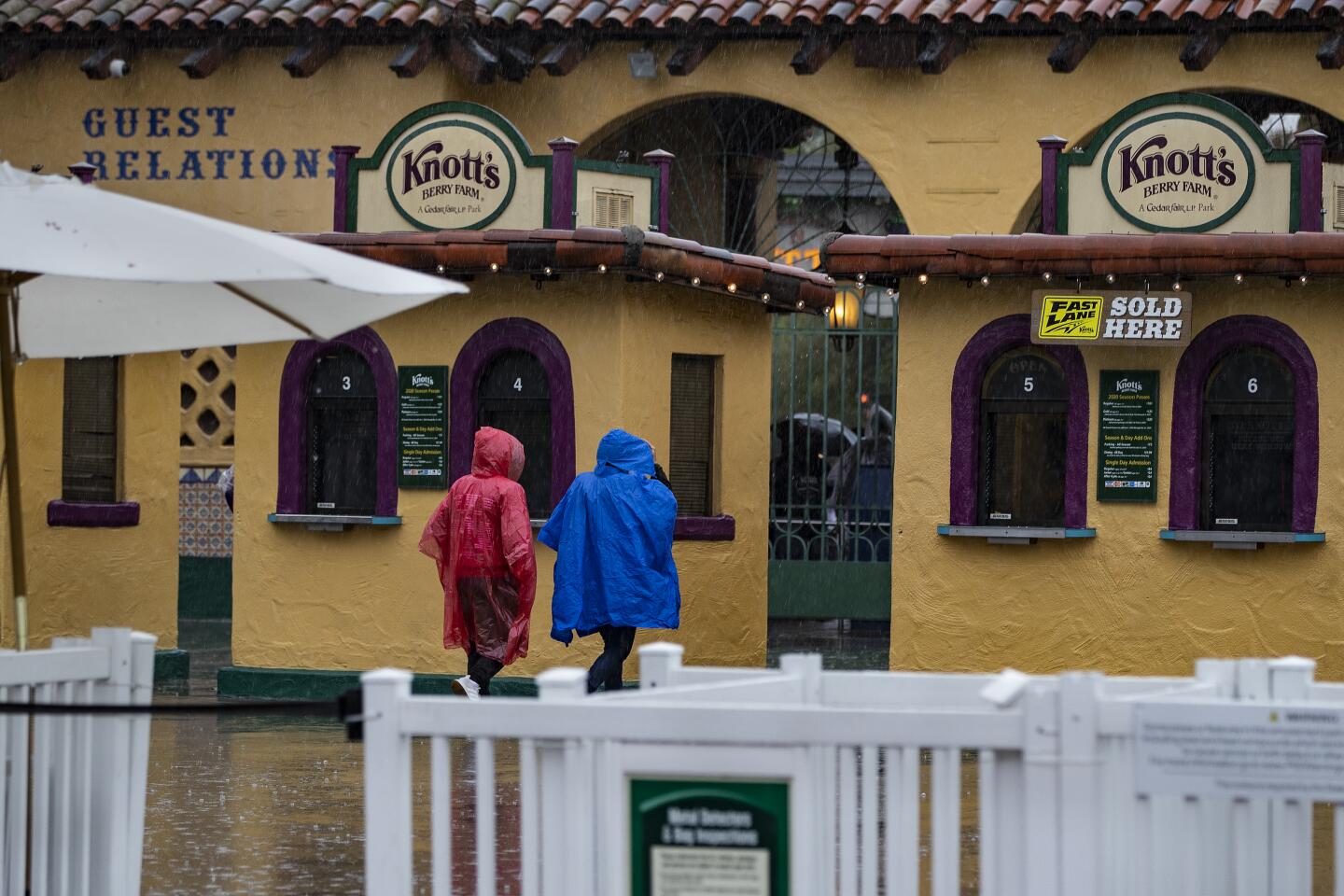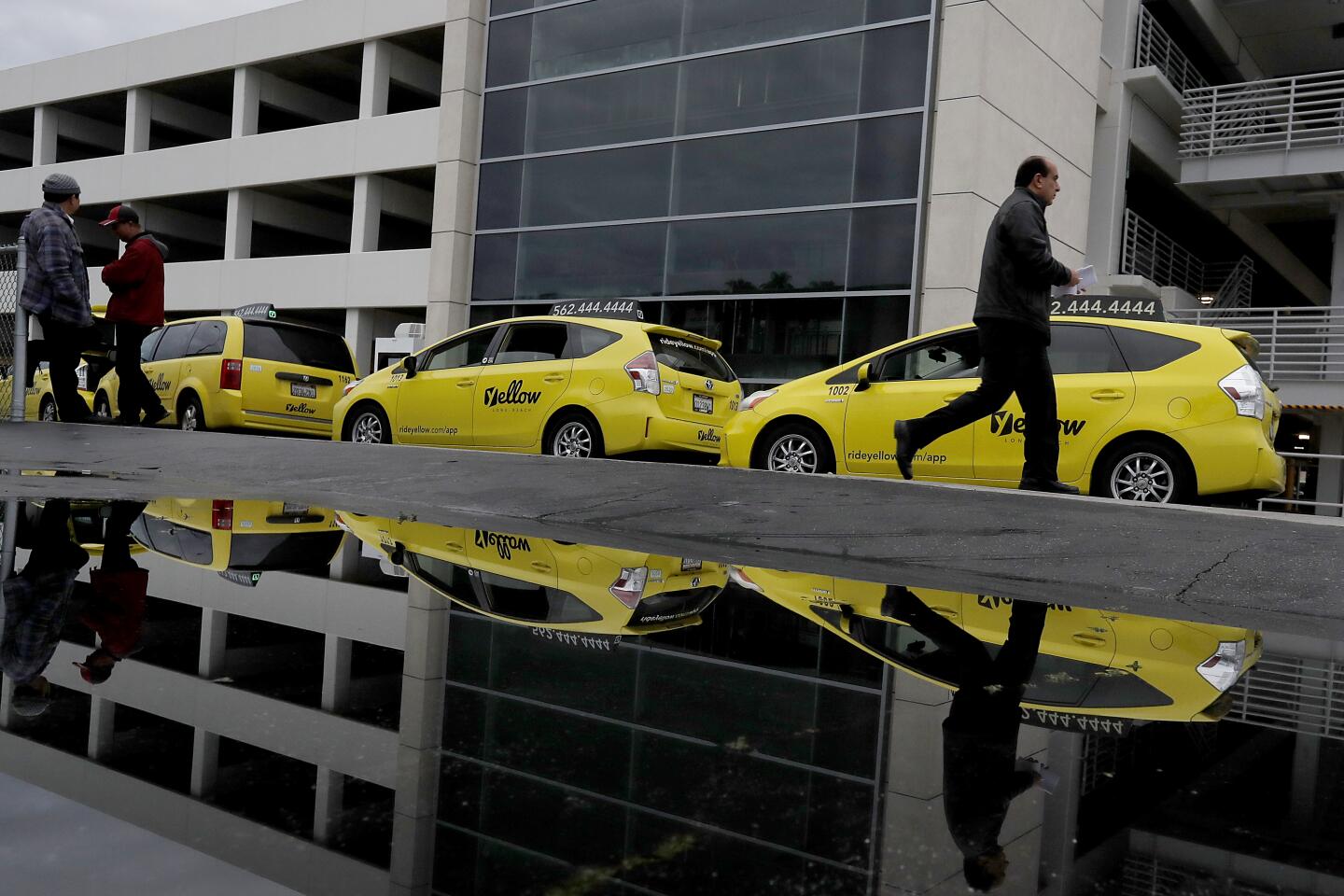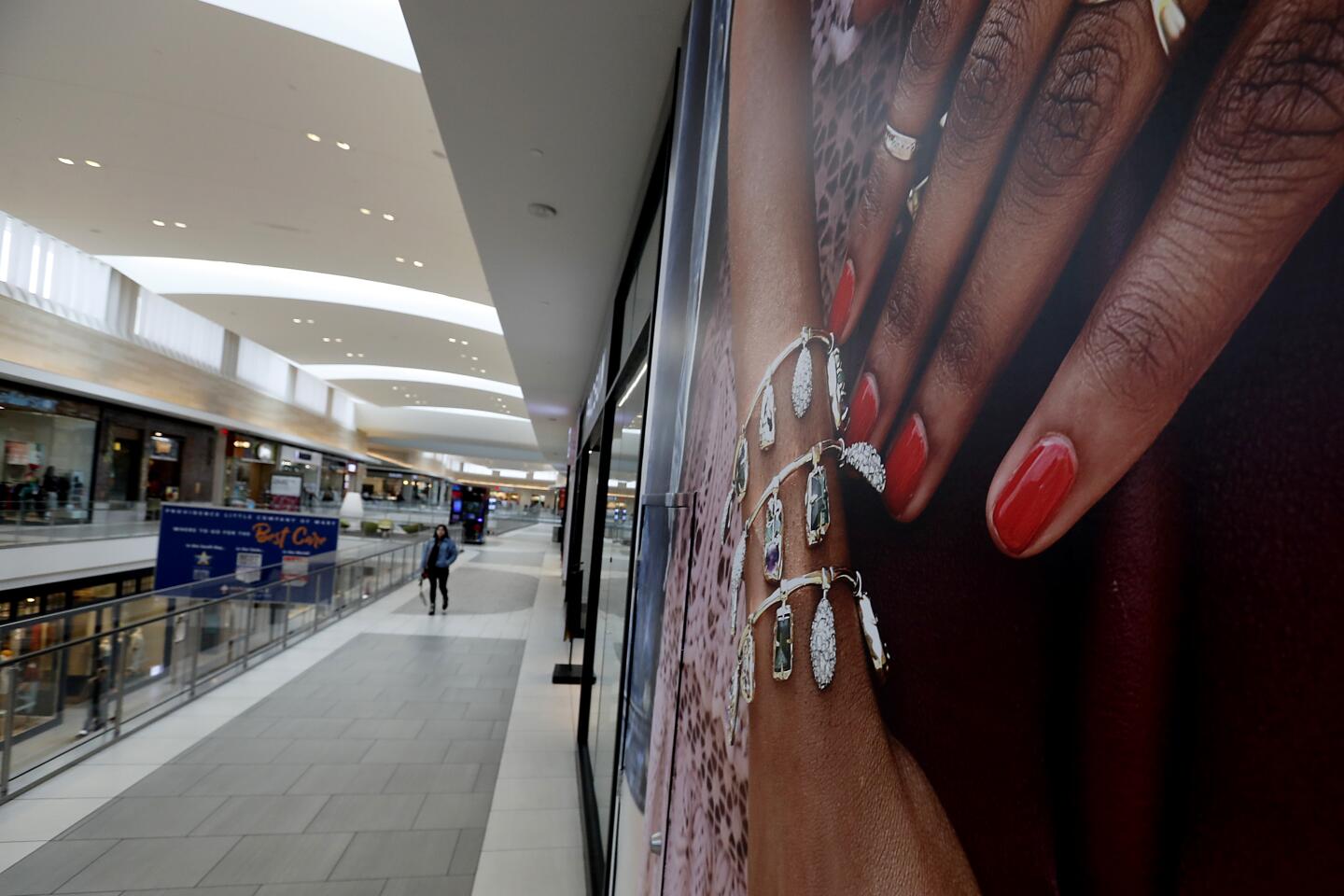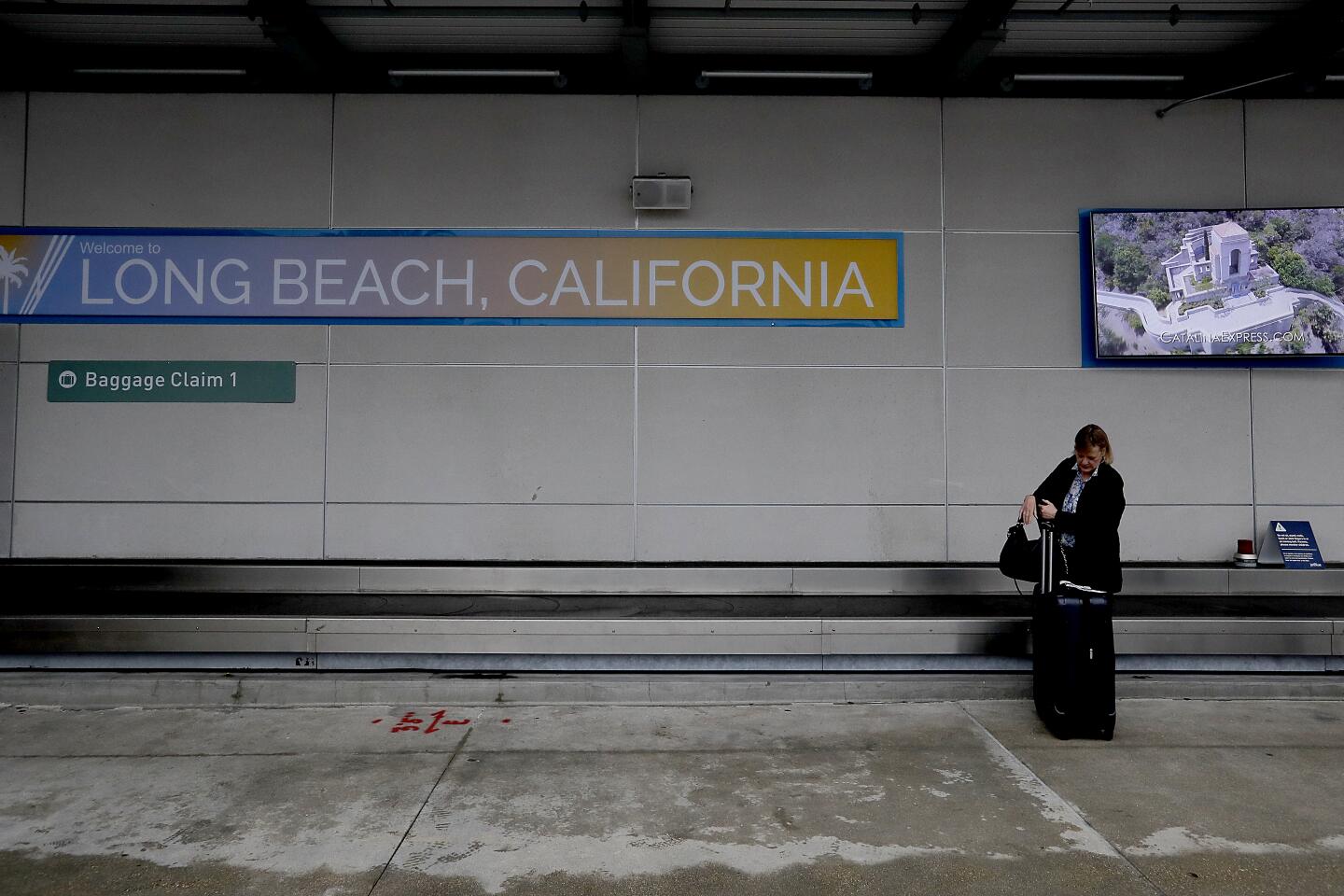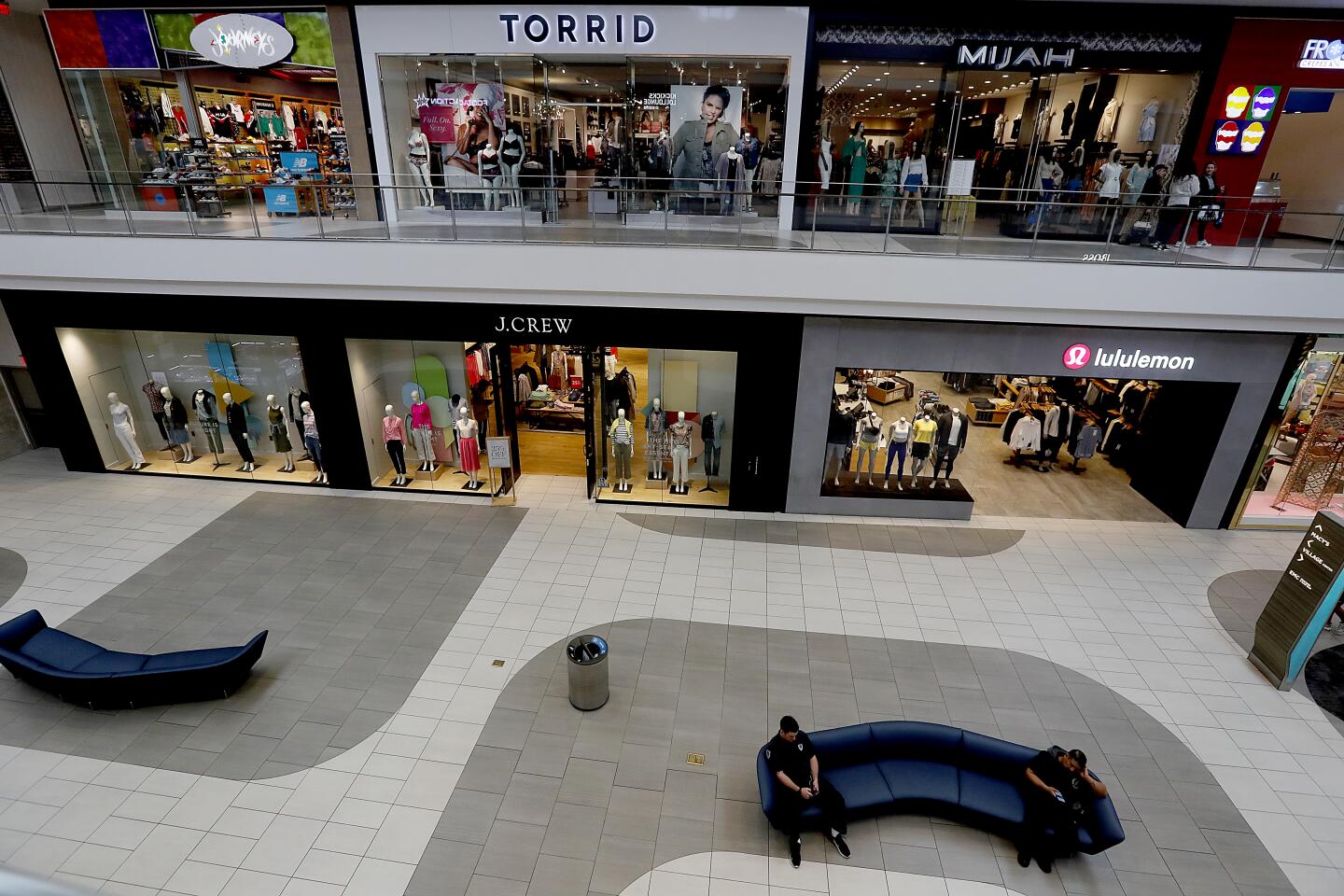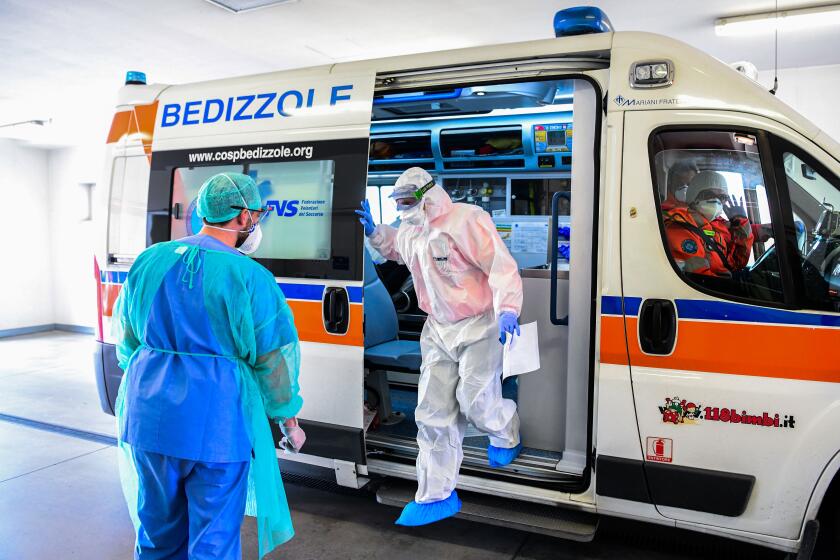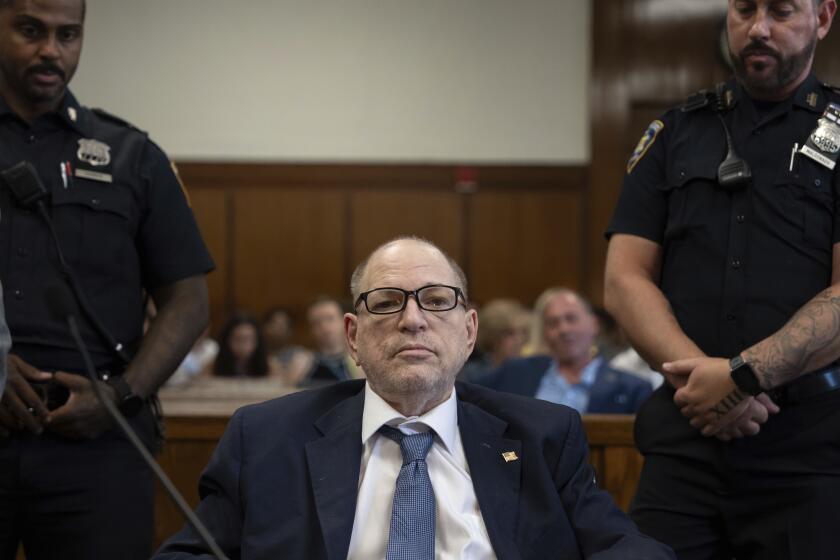As officials grapple with coronavirus pandemic, more than 8 million Californians are living under shelter-in-place orders
- Share via
More than 8 million Californians are living under shelter-in-place orders — the nation’s most stringent public health measures yet — as state and local governments rush to address the coronavirus pandemic.
At least 10 counties in the Bay Area and Central California and the city of Palm Springs have directed all residents to stay at home as much as possible, with Sonoma, San Benito and Monterey counties deciding Tuesday to join the order implemented a day earlier by San Francisco, Santa Clara, San Mateo, Alameda, Contra Costa, Marin and Santa Cruz counties. In Ventura County, health officials Tuesday announced a shelter-in-place order that applied only to older residents.
In total, about 20% of the state’s population is under shelter-in-place orders.
Southern California authorities stopped short of shelter-in-place orders, but still imposed sweeping restrictions. Orange and San Bernardino counties issued new orders Tuesday that ban all gatherings, a day after Riverside County banned gatherings of 10 or more people and L.A. County prohibited gatherings of 50 or more people. San Diego County issued a ban Tuesday prohibiting gatherings of 50 or more people.
Restaurants in many of California’s most populous areas are now being ordered to offer food only via pick-up and delivery. Besides the 10 counties imposing a shelter-in-place order, enforceable as a misdemeanor, Los Angeles, Orange, San Bernardino, Ventura and San Diego counties ordered restaurants to end dine-in eating and required them to offer only pick-up and delivery service.
Los Angeles, Orange, San Bernardino, Ventura and San Diego counties ordered bars that do not serve food to close; Ventura, San Bernardino and Los Angeles counties also ordered gyms and movie theaters to close.
The heightened restrictions come after California has seen the number of confirmed coronavirus cases continue to rise: 472 cases and 13 deaths as of Tuesday, compared to 157 confirmed cases and three deaths a week prior.
L.A. County, which hasn’t issued a shelter-in-place order but has required the closure of restaurants and several other businesses, announced it had 147 confirmed cases of the coronavirus, up 53 from Monday.
“We continue to see a huge increase in the number of cases,” public health director Dr. Barbara Ferrer said during a news conference Tuesday, adding that the rise in numbers is largely due to the increased capacity for testing.
Ferrer stressed the need for people to stay home, including anyone who is sick.
“If you’re sick and you’re an essential worker, please don’t come to work,” she said. “We cannot have people that are sick, even with mild illness, going about their business.”
The latest updates from our reporters in California and around the world
More distressing news came Tuesday when Gov. Gavin Newsom confirmed that California public schools are likely to be closed for the remainder of the school year in response to the coronavirus.
“Don’t anticipate schools are going to open up in a week. Please don’t anticipate in a few weeks,” Newsom said during a Sacramento news conference on the state’s coronavirus efforts. “I would plan, and assume, that it’s unlikely that many of these schools — few, if any — will open before the summer break.”
Nearly all school districts in the state, 98.8%, are closed in response to the pandemic, Newsom said. The state education department is assembling detailed guidelines on how schools can attempt to continue teaching 6.1 million students out of their classrooms in the weeks and months ahead.
Newsom said his daughter was upset Monday night about missing her school friends. He said he sat with her for about an hour to help calm her down.
“And if I could tell my daughter that, and not tell your daughter that, or the people, then I’m not being honest or true to the people of the state of California,” Newsom said.
He then added: “Boy, I hope I’m wrong.”
California public schools will not open for weeks and possibly not until summer, Gov. Gavin Newsom said Thursday afternoon.
Officials in Los Angeles County also announced a moratorium on all no-fault residential and commercial evictions, starting retroactively on March 4 and lasting until May 31. Tenants will have six months after the end of the emergency proclamation to pay for lost rent, L.A. County Supervisor Hilda Solis said.
Also, as concern over the coroanvirus grows, officials said there’s been a decline in blood donations. Nearly 160 blood drives have recently been canceled, resulting in 5,500 fewer donations. Officials are asking those who are healthy to continue to make a donation, which has a shelf-life of roughly 42 days.
The coronavirus pandemic has prompted officials to take extraordinary measures to try to slow the spread by closing businesses, demanding that older individuals stay home and trying to increase testing for the virus.
Two new deaths were reported Tuesday in California, one in the Coachella Valley in Riverside County and a man in his 50s in Santa Clara County who was hospitalized March 9 and died Tuesday.
More than 470 people from across the state have tested positive for the virus, but officials admit that is just a fraction of the real number.
A lack of tests had made it impossible for officials to get a clear handle on the numbers or the spread. To date, roughly 58,878 people have been tested for COVID-19 in the U.S., Health and Human Services Assistant Secretary Adm. Brett P. Giroir said during a news briefing Tuesday.
President Trump said that all states now have the ability to authorize and use tests, and officials insist change is coming.
By the end of the week, more than 2,000 commercial labs across the nation will be performing coronavirus tests using high-speed machines that can process many samples at once, federal officials said Sunday. About 1.9 million tests would be available by the end of the week, officials said.
California will be running 8,000 tests a day in about a week, when the commercial lab company Quest opens up two more labs, according to the governor’s office.
Trump also said he spoke with restaurant executives earlier, and stressed the importance of takeout and delivery options and workers who will continue to make those services available, while reiterating the call for people to work from home.
“We’re asking everyone to work at home if possible, avoid unnecessary travel and stop gathering in groups of at least 10,” he said. “By making shared sacrifices and temporary changes, we can protect the health of our people, and we can protect our economy.”
Nevada Gov. Steve Sisolak announced Tuesday statewide closures of all non-essential businesses starting noon Wednesday and midnight for all gaming — including Las Vegas casinos — for 30 days.
Los Angeles County officials announced the closure of all bars, fitness centers and movie theaters and directed restaurants to move to takeout only. The directive applies to all 88 cities and unincorporated regions of the county, including Los Angeles, which issued a similar directive Sunday.
Gov. Gavin Newsom made a similar announcement Monday evening, asking all California restaurants to close their doors to dine-in customers and that gyms, health clubs and movie theaters should also shutter their operations.
“We’re asking people to shelter in place, to isolate at home,” Newsom said during an update broadcast on Facebook Live. “The point of gatherings is lost on all of us from a public safety and health perspective. So directing ... no gatherings … we think it’s very rational under these circumstances. Disruptive, I know, for some. But rational, we believe, in this moment.”
Shelter in place, severe restrictions
On Tuesday, Orange County, Ventura County, Monterey County and the central California county of San Benito, just south of Santa Clara County, also announced severe restrictions in an effort to stem the spread of the new coronavirus. To date, 10 counties have issued such orders, with Ventura County’s being somewhat less restrictive than the others.
Ventura County health officials issued a shelter-in-place order — a misdemeanor punishable by fine or imprisonment if violated — requiring anyone 75 or older, and anyone 70 or older with an underlying medical condition, to shelter in place at their home starting Wednesday through April 1. Older residents covered by the order are allowed to go outside to seek medical care and food, and to perform essential work in healthcare and government.
The order also requires all restaurants to provide only takeout and delivery. The county also ordered the closure of all bars and nightclubs that do not serve food, movie theaters, live performance venues, bowling alleys, arcades, gyms, community pools, wineries, breweries and tap rooms that provide tastings.
At an emergency City Council meeting Monday morning, Palm Springs city leaders issued an order advising all residents to shelter in place and limit their activities.
“Forty percent of our residents are aged 60 and above. We also have many with underlying chronic health issues and compromised immune systems. The Coachella Valley has 17 individuals who have tested positive and three deaths in the past 24 hours. We also had three firefighters quarantined due to exposure to someone who tested positive. These all resulted in my calling the emergency meeting and council taking the action we did,” Palm Springs Mayor George Kors said.
The latest maps and charts on the spread of COVID-19 in California.
San Benito County made its decision after identifying a fourth case of coronavirus — a 42-year-old resident of Hollister who appears to have been exposed while working in Santa Clara County. The patient is isolated in his home.
The order was similar to the one issued by six Bay Area counties and Santa Cruz County on Monday. It allows people go out and shop for food, go to the doctor’s office, check on relatives and go outside for exercise, but to otherwise stay home, with exceptions for essential services.
“Even though we haven’t had as many cases in San Benito County up until now, there have been numerous cases and evidence of extensive community widespread in Santa Clara County and other counties,” said Dr. Martin Fenstersheib, the county health officer. “There’s increased risk for people to be exposed in other counties and then to come back into this county.”
Monterey County issued a similar order, enforceable by a fine or jail.
“Now is the time to do everything we can to prevent the situation from getting much worse in a matter of days or weeks. Every hour counts,” the Monterey County health department said.
Over the past two days, public health officials in San Francisco and several other counties — including Santa Clara, San Mateo, Marin, Contra Costa, Alameda, Monterey, San Benito and Santa Cruz — issued sweeping orders that force most businesses to close and residents to “shelter in place” inside their homes.
San Francisco Police Chief Bill Scott said police are asking the public to voluntarily comply. While violation of the health order could be enforceable as a misdemeanor, “that is an absolute last resort,” Scott said. “This is not about a criminal justice approach to a public health issue.”
In Napa County, where there have so far been no confirmed cases of the virus, public health officer Dr. Karen Relucio issued a health order limiting public and private gatherings. The order is not a shelter-in-place directive, officials said.
On Tuesday afternoon, Orange County issued severe restrictions that prohibits “all public and private gatherings of any number of people, including at places of work, occurring outside a single household” that are considered nonessential.
“We are taking these mitigation steps in line with a directive issued by Gov. Newsom to help slow the spread of COVID-19,” Orange County Health Officer Dr. Nichole Quick said in a statement. “We recognize community members may experience anxiety related to the social disruption caused by COVID-19, and want to encourage residents to reach out to loved ones using appropriate methods like telephone, video messaging, email and text.”
Also on Tuesday, Orange County Sheriff Don Barnes moved to decrease deputies’ contact with the public, closing front lobbies of stations, reducing in-person police reports and suspending visits to the jails.
“Our foremost responsibility is to keep the community safe, while implementing precautionary measures to safeguard the health of the public who rely on our service and the members of the department who respond to their call,” Barnes said.
All volunteer programs have also been suspended, including senior programs in contract cities and those provided by jail volunteers.
In San Bernardino County, health officials ordered Tuesday afternoon “the cancellation of gatherings of any number of people within the county starting tomorrow through at least April 6.”
Like most other orders, it also requires, starting Wednesday, the closing of all movie theaters, gyms, health clubs, bars, adult entertainment establishments and other businesses that serve alcohol but do not serve food.
“I understand this creates hardships for many families and businesses. But at the end of the day I believe we all understand that we are in this together, and that together, we will get through this,” said Board of Supervisors Chairman Curt Hagman, who announced the order online via a video. “The county is taking every step we can to stay in front of this threat.”
Ventura County Sheriff’s Capt. Eric Buschow said the department has moved deputies from investigative units and increased visibility at food shopping areas as part of its response to novel coronavirus.
He said the department is also screening new inmates in an open area outside the jail for health issues but is continuing at this stage to allow jail visitors. The county has 10 cases of the virus.
Sacramento County announced a partial closure of court operations in order to “promote public safety and health while protecting liberty and due process, “officials said.
Court calendars are being reduced to only “most essential” and “mandated” hearings, and telephone appearances will be used where feasible. The court building that handles traffic cases and small claims is closed, as are self-help centers. Cases deemed essential to public safety or where delay could cause irreparable harm to victims are continuing as scheduled, but nonessential criminal matters will continue in 30 to 45 days. And the county grand jury is deferred until mid-May.
California Supreme Court and L.A County courts previously made similar decisions.
More cases
As of Monday night, California had at least 472 confirmed cases. Of those cases, 82 are travel-related, 75 are person-to-person and 98 are community transmission. At least 193 cases are under investigation.
More than 11,750 people who returned to the U.S. through San Francisco International Airport or Los Angeles International Airport are self-monitoring
Riverside County confirmed a third death Tuesday. The first two deaths were linked to the Coachella Valley.
“Sadly, these outcomes are expected as we face a serious challenge and continue to make the necessary decisions to protect the health of the community,” Public Health Officer Dr. Cameron Kaiser said in a statement.
Santa Clara County confirmed two additional deaths, bringing that county’s total to four. And Sacramento County confirmed one person had died, bringing its total to two deaths, both people who were older than 70 and had underlying health conditions.
Officials said that all hospitals were preparing for a surge in patients.
Kern County confirmed its first case of coronavirus Tuesday. The individual is not a resident of the county, public health officials said.
Officials are working to identify potential contacts of the individual and will monitor the health of individuals who traveled with the person in an attempt to prevent any possible community transmission.
The number of positive tests in San Luis Obispo County doubled to to six. Dr. Penny Bornstein, the county’s public health officer, said of the three, two were in the northern part of the county and one in the south.
In Long Beach, the number of cases rose by three, bringing the city’s total to eight.
The three new cases include two individuals who traveled to locations of known outbreak and one person whose exposure is currently under investigation.
At least 110 people in the city are currently being monitored for the virus.
Schools struggle
Millions of families in Los Angeles and across the state were forced to adjust Monday to closed schools, child-care hassles, an uneven move to online learning and a strained social safety net — the education system fallout from an unprecedented effort to halt the spread of the coronavirus.
L.A. Unified announced more bad news: District officials late on Monday canceled their innovative effort to offer child-care, counseling and learning materials at 40 new family resource centers, citing health risks.
Instead, 60 “grab-and-go” food centers will be available for school families.
With almost all of California students out of school, many districts in the state were trying to move toward online education — an especially tall order in a state where 60% of students qualify for free or reduced-price meals because they are members of low-income households. In Los Angeles public schools the number is even higher, at 80%; in Compton it’s at 83%; Pomona, 89%.
Besides the potential for hungry children, in Los Angeles, for instance, this also means that one-quarter of families do not have broadband service and additional families lack adequate data plans or computers needed to support online learning, said LAUSD Supt. Austin Beutner.
Times staff writers Cindy Carcamo, Hannah Fry, Chris Megerian, Luke Money, Paige St. John and Richard Winton contributed to this report.
More to Read
Sign up for Essential California
The most important California stories and recommendations in your inbox every morning.
You may occasionally receive promotional content from the Los Angeles Times.
